




Welcome to a new academic year full of inspiration and challenge.
Last year was a singularly fruitful one for the School.Many will remember that in August 2000,Governor Ridge committed $18 million ofCommonwealth funds towards the $48 million cost ofthe new Teaching and Research Building. Through the great generosity ofour good friends and benefactors,we now have $30 million in hand;twothirds ofthe way to our goal! I am thrilled and grateful,particularly to the School’s Board ofOverseers who were instrumental in securing a significant proportion ofthese funds.In the next 12 months we must work hard to sustain this momentum and raise the remaining balance of$18 million.
Funding for the new $3.1 million Scott Equine Sports Medicine Building at New Bolton Center was accomplished in the past year,thanks to the broad support that New Bolton Center enjoys in the equine community and to the vigorous leadership ofHerbert and Ellen Moelis in securing funds.Herb Moelis is a distinguished member ofthe School’s Board ofOverseers.Construction ofthe Scott Building,which will greatly improve our ability to care for equine patients,is now underway and should be completed by the middle ofnext year in time for the celebrations marking the 50th anniversary ofNew Bolton Center.
In January we opened the new Swine Unit at New Bolton Center with the goal ofexpanding research in the area and providing more opportunities for our students to study swine medicine.I thank Dr.Tom Parsons for successfully spear-heading this project and am happy to announce that Dr.Gary Althouse,one ofthe best known experts in swine reproduction in the U.S.,has joined him on the faculty.Tom and Gary are now in a position to provide our students with one of,ifnot,the best programs in swine medicine in the country.I take delight in this prospect.
Another initiative is the new aquaculture
facility nearing completion at New Bolton Center.Drs.Leon Weiss and David Nunamaker are leading this project which will be named in honor ofRobert F.Fairchild,another illustrious member ofthe School’s Board ofOverseers, who generously contributed to the cost ofthe building.Among other things,it will be used by faculty in the Center for Animal Health and Productivity to study nutrition in farmed fish. In doing so,they will apply the skills they have gained in dairy nutrition to the aquatic environment since the principles ofnutrition are the same.Studies on infectious diseases offish will also take place in the building.These are important initiatives for improvements in nutrition and infectious disease control.These are two ofthe most critical problems facing the aquaculture industry today.
Buildings which support our educational, research,and clinical programs are just one facet ofthe rich intellectual environment that defines the School.In their surroundings,
students,faculty and staffcreate the School’s vigorous scholarly milieu and it is this critical attitude that our graduates take with them as they enter the veterinary profession and become leaders.James Thomson,the scientist who discovered how to culture human embryonic stem cells much in the news today,was a V.M.D./Ph.D.student at the School from 1981 to 1988 and is one such leader.We take pride in his accomplishments and draw great satisfaction in the beliefthat the School’s dynamic scholarly environment contributed to Jamie’s success.Our challenge is to preserve the vibrancy ofthis intellectual environment so that the School may continue to inspire the Jamie Thomsons ofthe 21st century.I eagerly look forward to working with you to secure this goal.
Alan M.Kelly The Gilbert S.Kahn Dean ofVeterinaryMedicine
Dr.James A.Thomson,a graduate ofthe Veterinary Medical Scientist Training Program at the University ofPennsylvania, has recently been named as America’s best in cellular biology research by Time magazine. Dr.Thomson received his V.M.D.in 1985 and his Ph.D.in molecular biology in 1988.He is a University of WisconsinMadison developmental biologist who also serves as a professor ofanatomy in the UWMadison Medical School and as the chief pathologist at the Wisconsin Regional Primate Research Center on the UWMadison campus.
According to Time,“Biologist James Thomson’s wizardry with embryonic stem cells had not only raised hopes for a medical panacea but also set offthe national debate on whether that potential public good

provided the moral justification for the infusion ofmassive amounts ofpublic money. Already,Thomson’s own personal balancing act — juggling scientific imperative and ethical caution,technical brilliance and moral quandary — had made him one of our choices for Time’s list ofAmerica’s Best in science and medicine.”Read “Stem Winder,”a profile ofDr.Thomson on the CNN/Time web site at <http://www.cnn.com/SPECIALS/2001/ americasbest/science.medicine/ pro.jthomson.html>.
Since joining the Wisconsin Regional Primate Research Center,Dr.Thomson has conducted pioneering work in the isolation and culture ofnon-human primate and human embryonic stem cells,undifferentiated cells that have the ability to become any ofthe cells that make up the tissues ofthe body.He directed the group that reported the first isolation ofembryonic stem cell lines from a non-human primate in 1995, work that led his group to the first successful isolation ofhuman embryonic stem cell lines in 1998.

Funds are growing for the Teaching and Research Building that will be built adjacent to the Veterinary School complex in Philadelphia.The project costs are estimated at $48 million.The School has raised almost two-thirds:$30 million!
Recent gifts for the Teaching and Research Building include a $1.5 million grant from The Connelly Foundation ofWest Conshohocken,Pa.The Foundation stated:“The University is a strong force for economic and intellectual good in the state ofPennsylvania and the Delaware Valley,and the accomplishments ofthe School ofVeterinary Medicine in veterinary research are indeed impressive.Like you, our trustees are convinced that a new academic and research facility is necessary for Penn to compete in the 21st century.By having at its disposal the proper tools to conduct sophisticated genetic research,Penn can surely achieve and maintain a position in the forefront ofveterinary medicine in the world.”
The Robert J.Kleberg,Jr.and Helen C. Kleberg Foundation ofSan Antonio,Texas,a




long time supporter of Dr.Ralph Brinster’s research,made a pledge of$1 million for laboratories in the new building for the Center for Transgenesis and Germ Cell Research.A contribution of$500,000 for the building was received from the Diane Lenfest Myer Foundation ofWest Chester,Pa.In making this gift,the Foundation wished to help the School advance its mission.
The building’s ground floor,first floor,and part ofthe basement will be devoted to spaces for students.Research laboratories,seminar rooms and support offices will occupy the upper three floors.
Two state-of-the-art lecture halls,each accommodating 150 students,will be entered from the ground floor.A student lounge will occupy part ofthe basement level and the ground floor.The library,extending over two levels,will house not only books and reference material but banks ofcomputers for easy access to online reference and teaching materials.There will be “smart”internet-connected seminar rooms throughout the building, enabling students,researchers and clinicians to gather for small group teaching and discussions.
$48 million goal
$30 million raised
Three day eventing is a tough sport.It’s the equine equivalent ofthe “Iron Man” competition.The sport grew out of military training,when it was vital for cavalry horses to be fit,nimble and utterly responsive to their riders’commands.Three day eventing combines the most demanding ofequestrian disciplines:dressage,show-jumping and crosscountry riding.
At the highest level ofthe sport,a very fit horse must demonstrate on Day One complete obedience while executing a variety ofpredetermined movements in the dressage arena. He must then be fit enough to undertake the endurance phase ofthe competition on Day Two,which requires that he go at a measured pace for several miles before and after galloping a steeplechase course.This is followed immediately by a veterinary check to ensure that he is still capable ofthe biggest challenge — several miles ofgalloping over rolling terrain along a course interspersed with as many as 28-30 fixed fences,some ofwhich will have more than one jumping effort involved.Once through this — the cross-country phase — the horse rests overnight and is presented on Day Three for a veterinary check.Ifhe passes that,he will go on to jump a show-jumping course over brightlycolored poles and fences in front ofa cheering crowd that will test his athleticism,his fitness and his calmness ofmind.
Ofthe thousands ofhorses that compete regularly in weekend horse trials,point-topoint races,and other equine competitions, only a very few reach the glamorous heights dreamed ofby every serious rider.One ofthose horses is a 16.2 hands bay gelding,owned by Mrs.Jaqueline Mars and trained and ridden by one ofthe world’s best-known eventers,Karen O’Connor.His name is Prince Panache (known in the stable as Nash),and not only has he become one ofthe best-known stars in Olympic and international three-day eventing, he is a “graduate”ofNew Bolton Center — a horse who might not have risen to stardom without the help of Dr.Virginia Reef and her outstanding team ofprofessionals in the Sports Medicine Section.
Karen O’Connor told Bellwether Nash’s story,shortly after she rode him to victory at the MBNA Fox Hall 3-Day Event in Georgia in May.Karen found Nash in England in 1993 and liked him immediately because ofhis
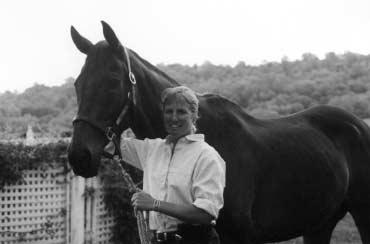
great,athletic jump.Apart from that,however, he was not very impressive in his movement –Karen refers to him having a “mincy little trot,” but she felt instinctively that he had great potential.Unfortunately,the relationship got offto a rocky start.Nash injured a foot before the purchase was finalized and it was serious enough to keep him laid up for about three weeks.In spite ofthis,Jackie Mars,trusting in Karen’s judgment,agreed to the purchase,and in the fall of1993 Karen brought the horse back to the United States and placed a very respectable 6th in the Fair Hill International 3-Day event in Maryland.
It was not until an insurance medical examination in 1995 that veterinarians detected that Nash had a slight heart murmur.“It wasn’t serious,”said Karen,“so we just continued competing.”The partnership showed great promise,with 8th place showings in the 1996 Rolex Kentucky 3* and Ireland’s 1997 Punchestown 3*.In 1998 Nash placed 5th at the sport’s premier event,England’s world-
d’equipe) said I must have gone over the top with him because he was “kick along quiet,” and that is NOT like Prince Panache.”Karen completed her dressage test and went on to do show-jumping that afternoon,when Nash was still “pretty lazy.”Karen says herselfshe did not know quite how to react.No-one listened to him with a stethoscope;as Karen said,“We just weren’t thinking along those lines.”
It wasn’t until the next phase ofthe competition that the wake-up call came.“He was charging along absolutely great at the start of the four-minute steeplechase.Suddenly,he just seemed to want to slow down,which is very uncharacteristic ofthis horse.I felt something had gone seriously wrong,but I wanted to finish the steeplechase and then check him,but we literally finished by trotting over the finish line.I was very,very scared at this point, because I’d never before had the feeling that I was on a horse that didn’t have any petrol left in his tank at all.It’s funny – I just knew it wasn’t a leg,but I also knew when I pulled him up
renowned Badminton 4*.Occasional injuries cut into his competition schedule,but by 1998 Nash had been successful enough to qualify for the World Equestrian Games in Rome.
It was there that Karen first noticed Nash might have a serious problem.“I was doing dressage and Nash was very,very lazy which struck me as odd because he is NOT a lazy horse.Captain Mark Phillips (USA team chef
that he was far from fit.I remember saying we had to get a vet,that I thought there was something wrong with Nash’s heart.” Catherine Kohn,VMD,and Kent Allen,DVM,team veterinarians,listened to Nash’s heart and diagnosed him as being in atrial fibrillation.
Nash was immediately retired from the competition.Karen said,“I was devastated and really scared that he was going to drop dead
right there.” Dr.Cathy Kohn,V’73 reassured her that the condition was not life threatening, but that Nash should have a complete cardiovascular work-up on his return to the USA. Before leaving Italy,however,Karen consulted with Cathy Kohn,Kent Allen and Brendan Furlong,top competition veterinarians.They unanimously recommended that Nash be taken to New Bolton Center and be seen,ifpossible, by Dr.Virginia Reef.Dr.Reef, they agreed,was unquestionably the finest equine cardiologist in the country,ifnot the world.As Karen remarked, “Thank goodness they didn’t tell me I had to take him to some place in California! At least I can get to New Bolton Center in about four hours, and I was grateful just for that.”
Karen brought Nash to New Bolton Center about six weeks after he had been initially diagnosed — basically when he was comfortable to ship home from a temporary stopover in England.Thus began a series ofvisits over a period ofsix months.“Dr. Reef,“ said Karen,“was a delight to work with because she is clearly a good horseman as well as a great veterinarian. She understands horses from both the veterinary perspective and the horseman’s viewpoint and this is a comfort to a horseman like me,who is clued into their personalities.I felt very at ease with her.I just felt that everyone at New Bolton Center really cared about Nash and what they were doing.And you know,at that point he wasn’t the star that he is today.He was just a horse we thought a lot of,but I told Ginny that ifwe could get him through his heart condition he could be a real worldclass horse as far as future competitions were concerned.”
Nash’s treatments and monitoring continued through the winter of1998-1999,and in
the spring of1999 Karen and Prince Panache qualified for the Rolex Kentucky 4* 3-Day Event,the only 4* level competition in the USA,and one ofonly 5 such competitions worldwide.It was only the second year for a 4* level competition to be run in the USA and very demanding,coming as it does at the beginning ofthe eventing season.Nash got star treatment from New Bolton Center.Dr.Reef
Steeplechase and Cross Country segment ofthe competition.It was a great team effort! Prince Panache placed first with an outstanding showing in all three disciplines ofthe event.
Since then,Prince Panache has never finished less than third in any top-level competition.Now 17,he is going into well-deserved semi-retirement,having won Rolex in 1999, and the Foxhall Farm 3* (Atlanta,Ga.) in 2001.
Nash also has to his credit a Team Bronze from the Sydney 2000 Olympics and a third place finish in the Rolex Kentucky 4* event in 2000.
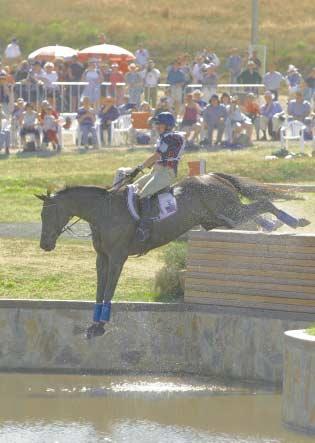
Karen O’Connor is grateful for what Dr.Reefand New Bolton Center’s expertise has done for her and Prince Panache,a horse both she and owner Jackie Mars are deeply attached to.But she remembers her first exposure to New Bolton Center with gratitude, too.Then,as a very young rider with no money and a horse diagnosed with terminal cancer, she recalled how kindly the staff treated her,particularly when she denied them the use ofher horse for teaching purposes.“It was too emotional for me,”she confided.“I just couldn’t handle it.But the doctor was so gentle with me and so understanding –my decision was totally fine with them.And I never felt as though they compromised that horse’s care because I was so young and scraping out a living. That first episode made me always want to go back to New Bolton,because ofthe care not just from the doctors but from the administration and everybody concerned.”
wrote a letter explaining all aspects ofNash’s care and treatment.New Bolton Center technicians were on site with portable EKG machines, and with the help ofKent Allen DVM,Karen’s local veterinarian,Nash was monitored at each phase ofthe demanding Roads and Tracks,
Prince Panache has earned his retirement and will be pursuing a less frantic schedule in the coming years.He has represented the USA with great skill and courage and he has earned a well-deserved place among eventing’s bestknown and best-loved equine athletes.That is due in no small measure to Dr.Virginia Reef and New Bolton Center.
Whether you are talking about travel, international trade,communication,or farming practices,the last three decades have witnessed sweeping changes and an inexorable move toward globalization. There are countless examples where these trends in human activity are a double-edged sword.Consider disease control.Clearly the rise in international traffic ofpeople,animals or things increases the risk ofimporting “exotic”diseases.At the same time,ease of communication and travel makes it possible to mobilize assistance at an international level,as was the case in the UK foot-and-mouth disease (FMD) epidemic.When,in early March,the UK Ministry ofAgriculture Fisheries and Food (MAFF) called for help,veterinarians and other disease experts from around the world offered their services.Penn’s Veterinary School was represented in this international effort by two members ofthe Center for Animal Health and Productivity at New Bolton Center, Dr.Linda Baker,V’84,and myself.
This story begins on February 19,2001,
when pigs suspected ofhaving FMD were identified at a slaughterhouse in Essex,in the southeast ofEngland.Presence ofdisease was confirmed the next day.The viral serotype
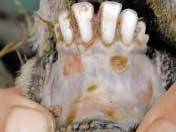
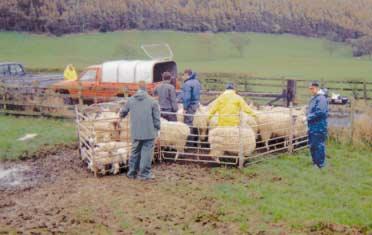
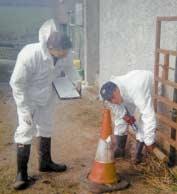
processor,and farm inspection revealed items such as paper plates and food wrappers that would not have been present ifonly properly processed swill were fed.Although the precise
On surveillance or tracing visits vets had to suit up for each farm,disposable coveralls were left there and boots disinfected several times before visiting the next farm.In most parts of the country,after being on an infected farm vets were considered “dirty”for 72 hours.“Dirty”vets either did nothing until they were “clean”again or continued working only on declared infected or contiguous premises slated for depopulation.Initially the dirty period was 5 days (equivalent to USDA guidelines) but as the epidemic progressed this was gradually reduced to 72 hours.In Cumbria life was chaotic with over 750 cases and at the height of the crisis the “dirty”period decreased to overnight.
(subdivision) involved was subsequently identified as the pan-Asian type-O strain described by the United Nations Food and Agriculture Organization as “pandemic.”Since its appearance in northern India in 1990,type-O has spread widely displacing other FMD serotypes and is present in most ofAsia,Japan, Taiwan,the Middle East,Russia,Mongolia, parts ofboth Africa and South America,and now Europe.
The initial Essex case was not,however, the source ofthe epidemic.All evidence points to the fourth case found,a cull-sow fattening operation in the northeast ofEngland that sent animals several hundred miles to slaughter at the index site where the disease was first discovered.Disease was most likely caused by feeding improperly treated pigswill. Although the farm in question was feeding swill from a licensed processor,the amount required exceeded that purchased from the
nature and origin ofthe infectious material remains unknown,it seems certain that one or several illegal actions resulted in the appearance ofFMD in the UK.Equally,it is difficult to imagine that globalization ofcommerce and travel were not important factors in the initiation ofthe outbreak and in its subsequent spread to Ulster,the Republic ofIreland, France,and the Netherlands.
Dr.Baker and I played out parts in this story between April 5th and May 4th when we were in the UK assisting with and researching the outbreak.Dr.Baker worked for MAFF under the auspices ofthe USDA,and was assigned to Lancashire in the northwest ofEngland.With support from Dean Alan Kelly,I was based in the northeast less than five miles from the source ofthe epidemic.Dr.Baker worked at a local level seeing how policies such as contiguous culling (i.e.,infected premises depopulated
within 24 hours,all susceptible animals on contiguous premises slaughtered within 48 hours) as well as protocols for control,surveillance,disease tracing,case identification and reporting,animal disposal,and animal movement were implemented in the field.I gathered information on how national policies were derived and the way in which they influenced local efforts.
I also examined epidemiological,legal, social,and international aspects ofthe outbreak. This combination of local and more global views provided a series ofvaluable insights and observations that neither one alone could have achieved.Our experiences ofwhat did and didn’t work,how procedures might be improved or modified to fit the US situation, particularly with respect to Pennsylvania agriculture,have already been presented at a Regional Emergency Managers Workshop.
The peak ofthe epidemic actually occurred around the time that we arrived in the UK.
During that week there were an average of40 new outbreaks per day,with 80,000 animals slaughtered and 83,000 carcasses disposed of on a daily basis.By the time we left in May,the
magnitude.While many may argue with the UK approach,and it was obvious serious mistakes were made,particularly early on,it was also clear that current technology for FMDV testing and vaccination is inadequate for disease control requirements.
Unquestionably, FMD has been a national disaster for the UK,coming as it does after the BSE epidemic and a 2000 outbreak ofclassical swine fever.Yet,as a lesson for both disease prevention and preparation for the unthinkable,international cooperation in disease management issues exemplified by our time in the UK will be invaluable in protecting animal health in Pennsylvania and the rest ofthe US.
For sheep,heavy lanolin-coated fleece made burning unsatisfactory and the primary means of disposal was burial,either on-site or at designated locations.There are several sites in the UK where between 100,000 and 300,000 sheep are buried.
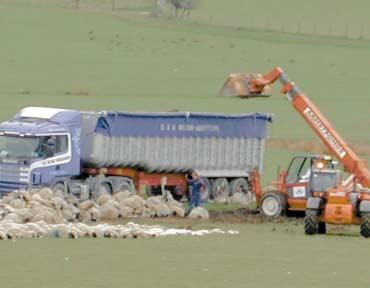
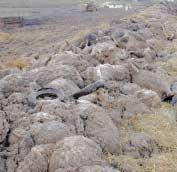
average daily cases had decreased to 7 per day, daily slaughter and disposal statistics were down to 16,000 and 21,000,respectively,and the epidemic was declared fully under control. Nevertheless,the disease continues to smolder and in the week ending July 15 (day 146) there were still an average of4 new cases per day, with daily slaughter and disposal at 7,000 and 6,000,respectively.The long “tail”ofthe disease is perhaps the most difficult time for control as lapses in vigilance and biosecurity become more common.Overall,there have been 1,854 outbreaks,but the contiguous culling policy has resulted in depopulation on 8,758 farms. More than 3.5 million sheep,cattle,pigs,goats and other susceptible livestock have been destroyed representing 8% ofthe UK national herd,when welfare and voluntary culls are included,this figure rises to 12% (a further 1.3 million animals).The numbers are staggering. Even for the best informed ofus,without first hand experience it is impossible to imagine the logistical and organizational resources necessary to conduct a disease control effort ofthis
http://aleffgroup.com/avisfmd/
http://www.iah.bbsrc.ac.uk/virus/ Picornaviridae/Aphthovirus/fmd.htm
http://www.maff.gov.uk/
http://www.oie.int/eng/en_index.htm
http://www.fao.org/waicent/FaoInfo/Agricult/ AGA/AGAH/EUFMD/default.htm
http://www.fao.org/
http://www.pighealth.com/
http://news.bbc.co.uk/hi/english/in_depth/ uk/2001/foot_and_mouth/default.stm
http://www.itn.co.uk/
http://www.guardian.co.uk/ footandmouth/0,7368,441391,00.html
http://www.aphis.usda.gov/oa/pubs/ fsmd00.html
No one has been to the Egyptian desert to excavate dinosaur fossils since before the First World War.In 1914 German paleontologist Dr.Ernst Stromer excavated abundant fossil fauna,including land and sea animals,plants and most excitingly, dinosaurs! Sadly all ofthese fossil treasures, though well documented,were destroyed in an Allied bombing attack on Munich in 1943.
owed and filmed the project for an expected television special.
The trip encompassed a six-week field season from January through February 2000. Although it was winter,temperatures varied from the 60’s to the 80’s.The nighttime lows hovered in the 40’s.The temperatures weren’t so much ofa factor since the team could dress for the cold but not for the dust storms. Thankfully,after January the storms abated and the most significant work was accomplished.
There were six new productive sites excavated as well as two old Stromer sites.The majority ofthe finds were ancient fish and sharks,as well as snakes,turtles and crocs and some tantalizing dinosaur clues.Several Spinosaurus teeth,a theropod claw and teeth and a sauropod caudal (long-necked dinosaur) vertebra were discovered.But the most intriguing find came only two weeks prior to departure.As soon as excavation started,they knew they hit pay dirt.Within a four-yard radius a number
ofidentifiable large bones were excavated.The centerpiece was the discovery ofa 5 foot,7 inch sauropod humerus,one ofthe largest ever found! There is no question that this is a major find.Extensive study and comparison ofthe bones with identified species has verified that this is an entirely new species.The name ofthe new dinosaur is Parallatitan stromeri,meaning tidal or coastal giant — stromeri honors Ernest Stromer.
The discovery was reported in the June 1, 2001 issue of Science.During a press conference at Penn on May 31 the team exhibited the humerus and provided details about the find. The story received world-wide coverage in the print and electronic media.The June Pennsylvania Gazette featured an extensive, illustrated article.It can be found online at <http://www.upenn.edu/gazette/0701/ prendergast.html>.A television documentary about the discovery will be aired in the near future.

In early 1999 Josh Smith,one of Dr.Peter Dodson’s (professor ofveterinary gross anatomy) vertebrate paleontology graduate students, decided to reinvestigate the wealth ofdinosaur fossils in Egypt’s Western desert.His two short days ofprospecting in the Bahariya Oasis revealed a number ofCretaceous-Age (100 million year old) fossils ofdinosaur and fish origin littering the ground.The following year,after some extensive fundraising to finance the project,Smith and Dodson put together a team of volunteers.They included Penn graduate paleontology students and geology colleagues, to return to Egypt and search for a new fossil fauna,the lost legacy.The team included geology students Matt Lamanna,Jen Smith and Allison Tumarkin,Patricia Kane-Vanni,Drexel University geology instructor Dr.Ken Lacovara, Academy ofNatural Sciences fossil preparator Jason Poole,other volunteers and an intriguing addition,the MPH production company,a major underwriter ofthe project.MPH shad-
Dr.Jill Beech,V’72,professor ofmedicine and chief,section ofmedicine and reproduction at New Bolton Center,has been appointed the first Georgia E.and Philip B. Hofmann Professor in Equine Medicine and Reproduction. The new professorship will be celebrated on September 19 at New Bolton Center. Dr.Beech will give an inaugural lecture entitled “A Tribute to New Bolton Center,Its Patients and Friends.”
Dr.Beech,after graduation,completed an internship in pathology at the School.In 1973 she was an intern at New Bolton Center,then a resident.She was appointed as an instructor in medicine in 1976 and joined the faculty in 1977 as assistant professor of medicine.She became an associate professor in 1983,a full professor in 1993,and
section chiefin 2001.Dr.Beech’s primary research interest is in neuromuscular diseases ofhorses.Dr.Beech is an accomplished potter who has had exhibitions at area galleries.Her pieces are always “snapped up”at the annual SCAVMA Auction.
The Georgia E.and Philip B. Hofmann Professorship is the 18th endowed chair at the School.It was established through the estate ofGeorgia Hofmann,an owner and breeder ofThoroughbred horses.Mr.and Mrs.Hofmann were avid horse enthusiasts and had a long relationship with the School.In 1970 they established the Georgia and Philip Hofmann Center for Animal Reproduction at New Bolton Center.Mr.Hofmann served on the School’s Board ofOverseers and was chairman for a number ofyears.
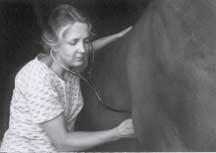
infections can retard and even halt the growth oftumors in mammals by blocking the formation ofblood vessels that nourish those tumors,researchers at the School have found.The finding,reported in the Cutting Edge section ofthe May 15 issue ofthe Journal ofImmunology,offers researchers an important new lead on ways to block angiogenesis,the growth ofnew small arteries and veins.
Serious“This finding suggests that infected animals could be a source ofnew,extremely potent inhibitors ofangiogenesis,the Holy Grail of modern anti-cancer research,”said lead author Andrei Thomas-Tikhonenko,an assistant professor ofpathology at the School.
The result also turns on its head decades of dogma among immunologists,who had believed that when the cells ofthe immune system were mobilized against life-threatening infections,tumors also fell victim to this fortification ofthe body’s defenses.Now,ThomasTikhonenko’s work has shown that during infection tumors don’t grow even in animals with severely weakened immune systems.This indicates that it’s the suppression ofangiogenesis,not antigen-battling lymphocytes and macrophages,that holds the key to this longrecognized phenomenon.
“This is a whole new way oflooking at how cancer can be inhibited in mammals,”said John Hibbs,professor ofinternal medicine and chief ofthe Infectious Disease Division at the University ofUtah,who has conducted research on infection-mediated suppression oftumorigenesis.“For a number ofyears,immunologists have regarded this process as a cytotoxic effect mediated by lymphocytes and activated macrophages.This work shows that infections also inhibit tumors by a surprisingly different mechanism.”
Thomas-Tikhonenko’s research,which has not fingered a specific factor that blocks angiogenesis in infected animals,creates a kind of scientific whodunit.The Penn team is searching for the mystery molecules,pressed into service by infections,that so strongly inhibit the growth ofvascular tissues inside the tumors.
“We are very much interested in identification ofthese ‘culprits’because we believe that they will be extremely useful therapeutic agents not only for cancer but also for other diseases
where unwanted angiogenesis takes place,” Thomas-Tikhonenko said.Angiogenesis is known to play a role in diabetic retinopathy,a leading cause ofblindness,and endometriosis, a major contributor to female infertility.
The first observation that infection interferes with tumor growth was made more than 100 years ago by a New York surgeon,William B.Coley,who noted that streptococcal infection caused regression ofsoft tissue sarcomas in human patients.Traditionally,this resistance has been explained by stimulation ofantitumor immunity.
“However,direct proofofthis mechanism has never been obtained,and therapies based on it have not materialized,”ThomasTikhonenko said.“In our paper,we demonstrate,for the first time,that infection-induced resistance need not involve any ofthe immune responses that might limit tumor growth.”
Two separate lines ofevidence suggested to the Penn researchers that the immune system doesn’t play a crucial role in inhibiting tumors. First,in strains ofmice lacking the cells normally found on the front lines ofthe immune system — T-lymphocytes,macrophages and NK cells — tumor growth was nevertheless suppressed when the protozoan Toxoplasma gondii was contracted.Further support came from the earlier observation that the tumor under investigation,the B16 variant ofmalignant melanoma,produced no antigens recognizable to the mouse’s immune system.
After he had ruled out the immune system as intermediary between infection and tumorigenesis,Thomas-Tikhonenko was tipped offto angiogenesis’role by co-author and toxoplasmosis expert Christopher Hunter,associate professor ofparasitology at the School.Hunter suggested that the same mouse proteins designed to guard the host against Toxoplasma gondii might also inhibit growth ofblood vessels.This suggestion proved correct:in a pilot experiment,the injection ofpowerful angiogenic compounds into mice with toxoplasmosis failed to induce growth ofnew blood vessels under the skin,a phenomenon that has important implications for cancer.
The tiniest oftumors don’t require their own blood vessels,relying on simple diffusion ofoxygen and nutrients from nearby cells.But by the time they’ve grown to two or three millimeters in size,tumors need the nourishment provided by blood vessels in order to survive.
The laboratories ofThomas-Tikhonenko and William Lee at Penn’s School ofMedicine found that at this stage,where angiogenesis becomes crucial,melanomas developing in infected mice experience severe lack ofoxygen but are unable to recruit new endothelial cells to produce blood vessels.
Thomas-Tikhonenko’s findings suggest that Toxoplasma gondii-infected animals could be used to purify molecules that halt the sustenance oftumors.Although several antiangiogenic compounds have been recently identified,their efficacies are yet to be proven in clinical trials and none ofthem has been approved by the Food and Drug Administration for the treatment ofcancer patients.
The drive to pinpoint the exact chemical factor that prompts infections to block angiogenesis will likely take months,possibly years. “It might be a combination ofwell-known molecules such as interferons or an entirely new compound,”Hunter said.
Thomas-Tikhonenko and Hunter’s coauthors on the Journal ofImmunology paper are Duonan Yu, Cam Ngo, Cinzia Sevignani, Michael Goldschmidt and Sidney Evans of Penn’s School ofVeterinary Medicine;Michael Gee and William Lee ofPenn’s School ofMedicine;and Tatyana Golovkina ofthe Jackson Laboratory in Bar Harbor,Me.Their work was funded by the National Institute ofAllergy and Infectious Diseases,the National Cancer Institute and the University ofPennsylvania Cancer Center Pilot Projects Program.
Dr.Ilana Reisner has been appointed assistant professor ofbehavioral medicine and director ofVHUP’s behavior clinic.Dr. Reisner came to Penn from Cornell University’s College ofVeterinary Medicine where she was a visiting fellow.She received her D.V.M.degree from the Veterinary College at Oregon State University and then went to Cornell for a Ph.D.in behavioral physiology with an interest in canine aggression. During part ofher residency in behavioral medicine at Cornell,Dr.Reisner was a Morris Animal Foundation Fellow.Dr. Reisner became a diplomate ofthe American College ofVeterinary Behaviorists in 1995.
The 24th Annual Feline Symposium was held on Saturday,March 24 at VHUP. The event was generously supported by Sheba® and Mrs.R.V.Clark,Jr. and Mrs.Edith Young.Five faculty gave presentations.This year the Parade ofBreeds focused on four related breeds which were presented and explained by their breeders.The day ended with the traditional wine and cheese reception, hosted by Liz Clark and Edith Young.
Following are summaries ofthe faculty presentations:
Hyperthyroidism is the most common endocrinopathy in cats.It is also one ofthe most debilitating,said Dr.Cynthia Ward,associate professor ofmedicine at VHUP.Dr.Ward discussed the pathogenesis,clinical manifestations,diagnosis and treatment options for feline hyperthyroidism.
Unrecognized in cats until 1979,hyperthyroidism has since become an increasingly common diagnosis.Although the etiology is unknown,recent evidence has linked the disease to the use ofcanned cat food (2-3-fold risk) and cat litter (3-fold risk).With no reported breed or gender predilection,hyperthyroidism usually occurs in cats older than seven years ofage.
Thyroid hormone,which is manufactured by the thyroid gland,produces widespread systemic effects emanating primarily from its role in increasing metabolic rate.In the hyperthyroid cat,the thyroid gland is overproductive as a result ofeither benign (98% ofcases) nodular or generalized hyperplasia.
“The hormone released by these cells that become unregulated makes the cat change in so many ways,”Dr.Ward explained.While sometimes subclinical,feline hyperthyroidism may produce clinical signs that include elevated activity level,ravenous appetite,weight loss, polyuria/polydipsia and vomiting.On physical exam,affected cats may be thin and have a palpable thyroid gland and abnormal cardiac auscultation (tachycardia,gallop rhythm,heart murmurs).
Most cases are diagnosed by an elevated T4 level.For those that cannot be diagnosed by T4 measurement alone,a T3 suppression test or T4 in combination with a free T4 by dialysis
measurement is usually diagnostic.Since thyroid hormone has multisystemic effects,supplemental tests should be performed in confirmed cases to evaluate other organs and systems that may be affected,particularly the kidneys,heart,nervous system and gastrointestinal tract.
Feline hyperthyroidism can be treated medically,surgically or with radiotherapy (131I), which is the treatment ofchoice in cats without concurrent renal disease.One subcutaneous injection of131I,which kills hyperfunctional follicle cells,is curative in 95 percent of cases.The medical treatment ofchoice is methimazole (Tapazole),which works quickly to regulate thyroid hormone production.The third option is surgery,in which both thyroid glands are usually removed.
There exist a variety ofbehavior disorders to which cats are predisposed.In order to minimize suffering for cat and owner alike,these problems should be promptly addressed,said Dr.Diane Frank,whose lecture focused on feline elimination disorders.Feline elimination disorders can be categorized as medical and behavioral.Medical causes,which must be ruled out first,can include feline lower urinary tract disease (FLUTD),renal disease,diabetes mellitus,hyperthyroidism,colitis,constipation, arthritis and neoplasia.Ifmedical etiology for a feline elimination disorder is suspected,a variety oftests may be performed,including urinalysis,urine culture and abdominal radiographs.The primary behavioral causes of feline elimination disorders are litter box-associated aversions/preferences and aggression. Aversions can be associated with litter box type,number,location(s),odor,cleanliness and substrate (type,texture,depth).Preferences, likewise,can be associated with the same variables,particularly substrate factors.How to differentiate a location from a substrate preference? Dr.Frank recommended placing a litter box on the soiled location and then monitoring whether the cat eliminates in the litter box or next to the box.Ifit is a location preference the cat will use the box.Ifit is a substrate preference the cat will not use the litterbox in the new location,.
Ifa substrate preference is suspected,Dr. Frank explained,one might “ask the cat what
the cat prefers”by making available three (different) litter boxes,each with a different litter type.
In multicat households,active and passive intercat aggression may be the root ofelimination disorders.Aggression,particularly when passive,can be covert and easily missed.Owners must carefully observe their cats for aggressive behaviors.Elimination disorders can also be manifest as marking,which can occur for various reasons,including social interactions between household cats,presence ofoutdoor cats,household changes (i.e.,new pet or person) and other anxiety-provoking situations.
Treatment for feline elimination disorders varies with the cause.For litter box issues, changes may be made in the box type,number, location(s) or substrate.For intercat aggression, options include no intervention,separating the cats,and interrupting aggressive interactions. Severe aggression requires environmental changes,behavior modification and medication.To curb marking,psychotropic medications are generally also required.
Diabetic ketoacidosis (DKA) is the most severe — and sometimes deadly — sequela of diabetes mellitus (DM). Dr.Rebecka Hess, assistant professor ofmedicine,presented an overview ofDM and DKA.
The pancreas produces a variety ofcritical enzymes and hormones.One ofthese is insulin,an anabolic hormone that facilitates cellular uptake ofglucose,fatty acids and amino acids for storage as carbohydrate,fat and protein.Insulin is the most important problematic hormone in DM.DM occurs in one oftwo forms.Type I — or insulin-dependent — DM is the form typically seen in cats and dogs.Here,the pancreas does not secrete adequate amount ofinsulin due to destruction ofthe beta cells that produce the hormone.
The primary clinical signs ofDM,which usually occurs in middle-aged to older cats,are polyuria/polydipsia,weight loss and hind limb lameness.Abnormalities that may be present on physical exam include obesity, hepatomegaly,lethargy,plantigrade stance and acetone breath.
Diagnosis ofDM involves documenting glucosuria and persistent hyperglycemia.Other
diagnostics,such as CBC,chemistry panel,urinalysis,and urine culture should also be performed to detect the presence ofconcurrent diseases like hepatic lipidosis,acute pancreatitis,urinary tract infection,hyperthyroidism and cancer.
Treatment ofDM in cats may incorporate several therapeutic modalities:insulin administration,dietary regulation,and oral hypoglycemics.In cats,human ultralente (long-acting) insulin — at a starting dose of0.5 units/kg BID — is most commonly used.The patient must consume its entire meal prior to each insulin dose.The optimal diet for the diabetic cat contains increased amounts ofinsoluble fiber and complex carbohydrates,and restricted amounts offat and protein.Additionally,a urine dipstick should be performed twice daily to monitor for glucosuria and ketonuria,and glucose curves should be done periodically to determine whether the insulin dose needs to be adjusted.
“It’s a lot ofwork to maintain proper regulation ofthe diabetic cat,”warned Dr.Hess, who added that the prognosis for these patients is good.
However,DKA a potentially fatal consequence ofDM — carries a guarded prognosis. DKA is caused by the breakdown ofintrinsic fat stores into ketoacids,resulting in acidosis. As a result ofextreme electrolyte alterations, affected cats may vomit and become weak, dehydrated,depressed,tachypneic and hypothermic.Emergency treatment with IV fluids/electrolytes and insulin is necessary to correct the acidosis.
Cats present to the ER for a variety ofreasons. Dr.Reid Groman,lecturer in emergency and critical care medicine at VHUP,highlighted three common and potentially serious feline emergencies:feline lower urinary tract disease (FLUTD),feline bronchial asthma,and acetaminophen toxicosis.
FLUTD is a very painful condition wherein a cat “blocks,”or becomes unable to urinate. Most common in neutered males,FLUTD can occur in females as well.FLUTD is a multifactorial disease;causes include diet,infection, parasites,anatomic abnormalities and urinary crystals.Cats are prone to developing struvite crystals,which are induced by high dietary magnesium.However,with the introduction of
magnesium-reduced,acidified,commercial diets,the incidence ofstruvite crystals has dropped and that ofcalcium oxalate crystals has increased.
Nonobstructive FLUTD,more common than obstructive FLUTD,typically presents with bloody urine and frequent,painful urination.It usually resolves spontaneously within a week.Obstructive FLUTD,which occurs almost exclusively in male cats,may be manifest as vomiting,vocalization and depression/ collapse.Diagnosis is made by history,clinical signs,palpation (firm bladder) and laboratory data.Treatment is with IV fluids to perfuse the kidneys and correct electrolyte abnormalities, sedation and catheterization to relieve the obstruction,and close observation for 24-48 hours.The prognosis for recovery is excellent, although some cats are prone to reblocking.
Feline bronchial asthma,a reversible, obstructive airway disease occurring most commonly in one- to six-year-old cats,is manifest by widespread narrowing ofthe airways. Possible causes include dusts,molds,pollen, smoke and parasites,although,said Dr. Groman,“We almost never know what sets off asthma in a cat.”
Clinical signs include wheezing,respiratory distress,increased respiratory rate and cyanosis. Diagnostic tests include radiography and orotracheal lavage.The condition may be treated with oxygen,and injectable/oral/ inhaled corticosteroids,bronchodilators and antibiotics. While the prognosis is generally good,Dr. Groman added that “Cats in respiratory distress are amongst our most fragile patients.”
“Acetaminophen toxicosis is one ofthe most devastating feline emergencies,Dr.Groman explained,“largely because it’s so preventable.”
Cats are uniquely sensitive to acetaminophen,present in most over-the-counter, aspirin-free pain relievers;a single Tylenol is lethal in the absence ofrapid treatment.Clinical signs ofacetaminophen toxicosis include cyanosis,facial/appendicular edema,respiratory distress and seizures.Affected cats may be treated with orally-administered activated charcoal (ifwithin two-three hours after ingestion) to decrease gastrointestinal absorption, oxygen,IV fluids,vitamin C,acetylcysteine and blood products.The prognosis for recovery is good iftreatment is instituted within four to six hours after ingestion.
Cats have evolved as true carnivores and thus have distinct dietary requirements. Dr. Kathryn Michel,assistant professor ofnutrition at VHUP,discussed the unique aspects of feline nutrition.
Because cats have adapted to a diet consisting primarily ofanimal flesh,they have lost the ability to synthesize a number ofamino acids, fatty acids and vitamins that are contained in their natural diet.Perhaps the most important ofthese are taurine (an amino acid found only in animal protein;taurine deficiency in cats can cause heart disease,retinal degeneration and reproductive failure),arginine (detoxifies the nitrogenous by-products ofprotein metabolism,a key metabolic pathway in cats) and vitamin A (cats have lost the ability to convert beta-carotene,found in fruits and vegetables, into vitamin A).
While the cat was perfecting its hepatic synthesis ofglucose from dietary amino acids (protein),it cast aside its need for dietary carbohydrates.Although highly speculative,links between carbohydrates — which are present in substantial amount in commercial dry foods — and obesity and diabetes mellitus have been made.
For this and other reasons,said Dr.Michel, “People are looking for alternatives to commercial pet foods because they have some concerns about their wholesomeness.”
Hence,raw food diets have come into vogue as oflate.However,after analyzing a number of these diets,Dr.Michel found disturbing nutritional imbalances and potentially-dangerous microorganisms therein.Therefore,she does not recommend these diets.
For cats that are on such non-conventional diets or that have increased nutritional demands,dietary supplements may be important.The main supplements thought to benefit cats are L-carnitine,chromium,vanadium and S-adenosyl methionine.However,Dr.Michel cautioned,the benefits ofmost dietary supplements are highly speculative.Few studies on their safety and efficacy in cats have been performed.And because they are not regulated by the FDA,these products should be used with discretion and under the advice ofa veterinarian.
J.C.G.
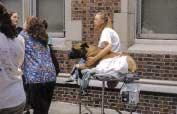
The afternoon ofAugust 14 brought some unwelcome excitement to VHUP.A fire broke out on the roof,causing smoke throughout the hospital.Alarms sounded at 2:50 pm and evacuation began quickly.All patients were safely removed from the hospital by nurses,students and staff.
When the many laddertrucks of the Philadelphia Fire Department arrived,they were greeted by the sight ofanimals on gurneys,hooked up to fluids and in some cases,oxygen,animals on leashes and in portable crates.They all were calm as they were constantly reassured and petted by nurses,students and staff.The firemen quickly extinguished the blaze on the roofand by 5:15 pm everyone was back in their accustomed places.
“Everyone was fantastic,”said Barry Stupine, vice dean and director ofthe hospital.“People knew exactly what to do and how to evacuate the animals quickly and safely.”Once animals and people where settled back in VHUP,office staffphoned all the owners ofthe hospitalized pets to tell them that their animals were safely back in the wards.
There were no injuries to either animals or people.The damage to the building was on the fourth floor.The news ofthe fire spread quickly and the news media flocked to the VHUP area with helicopters,cameras,microphones and notepads.Each ofthe five local TV channels,the radio and both papers carried the story and the emphasis was on how animal patients were safely evacuated from the building and made comfortable in various locations.
Dr.David Knight,professor ofcardiology and chief,section ofcardiology,retired on June 30,2001.

Dr.Knight,a 1962 graduate ofCornell University’s College ofVeterinary Medicine, came to Penn in 1964 to study at the then Division ofGraduate Medicine and to join the School’s Comparative Vascular Studies Unit,which pioneered the study ofveterinary cardiology.
On the faculty since 1967,Dr.Knight is a charter member ofthe American College of Internal Medicine and a member ofthe American Heart Association and the American Heartworm Society.During his tenure at the School,Dr.Knight served on many committees and was chiefofthe section of cardiology for many years.His primary research interests were pulmonary hypertension and heartworm disease.
Dr.Knight celebrated his retirement with a trip to Alaska!
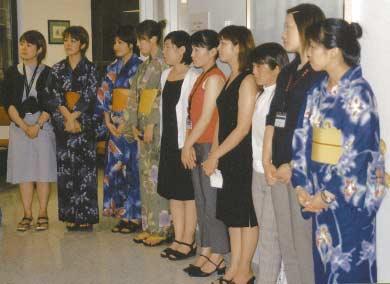
Each August faculty members who have been to Japan hone their Japanese vocabulary,as it is time for the annual visit ofveterinary students from Azabu University,Azabu,Japan.
This year ten students and two faculty members arrived.Eight students spent their time accompanying Penn veterinary students through clinic rotations at VHUP and two Azabu students did the same at New Bolton Center. The group spent 11 days at Penn and from their comments during the goodbye ceremony,they had an enriching and enjoyable time at the two hospitals.
Barry Stupine,director ofVHUP,has been promoted to vice dean for administration and finance.In July,Mr.Stupine,former dean Robert R.Marshak,and Dr.Neils Peterson of UC Davis,went to Israel to consult at the Koret School ofVeterinary Medicine at Hebrew University on faculty and academic issues,organizational issues and finances.
Dr.Charles Newton has stepped down as associate dean and is taking a sabbatical leave. Dr.Jeffrey Wortman,V’69,associate professor of radiology,has been promoted to associate dean ofthe School. Malcolm Keiter has been promoted to assistant dean for admissions and Ashra Markowitz has been promoted to assistant dean for student affairs.
Dr.Pamela Wilkins,assistant professor of medicine and reproduction,gave two platform talks at the ACVIM Forum in Denver,one on “Magnesium Infusion in Hypoxic Ischemic Encephalopathy”and the other on “Rabies in Large Animals”(the abstract was co-authored by Fabio Del Piero).Dr. Wilkins also presented a lecture on West Nile Virus to the Philadelphia Society for Religion and Science.
Dr.Christopher Hunter was promoted to associate professor of parasitology.
administrator,won a Models ofExcellence Award in April.This award is presented monthly by the University for suggestions that increase efficiency.
Dr.Gail Smith,V’74,professor ofsurgery and chair,Department ofClinical Studies,Philadelphia,presented a paper with data derived from the PennHIP database at the Veterinary Orthopaedic Society meeting in March,in Lake Louise,Alberta,Canada.
Dr.Cynthia Ward,V’87,was promoted to associate professor ofmedicine.Dr.Ward received an American Heart Association Research Grant.
Dr.Benson Martin,V’80,was promoted to associate professor ofequine sports medicine.
Dr.Michaela Kristula was promoted to associate professor ofmedicine in field service.
Dr.Gary Smith,professor ofpopulation biology and epidemiology,completed his one-year tenure as President ofthe New Jersey Society of Parasitologists in June 2001.Dr.Smith has
one-year grant from the University ofPennsylvania Research Foundation for a project entitled “Functional Analysis ofthe VP24 Protein ofEbola Virus.”He presented a poster at the 20th Annual Summer Symposium in Molecular Biology on Emerging Viral Diseases at Penn State University in June;the poster’s title was “Rhabdoviruses and the Cellular Ubiquitin/Proteasome System:A Budding Interaction?”
Johanna “Jeleen”Briscoe,V’02,won the Association ofAvian Veterinarians’2001 student manuscript competition with a paper entitled “Non-medical risk factors for feather picking in pet parrots”.She was invited to present this paper at the AAV annual meeting in Orlando,Fla.,August 2001.
Dr.Robert Poppenga,associate professor of veterinary toxicology,was the keynote speaker at the annual meeting ofthe Japanese Society of Clinical Toxicology in Tokyo in July.His topic was “The One Medicine Concept:Applications in Veterinary and Human Clinical Toxicology”.He also lectured to practicing veterinarians,veterinary students and veterinary faculty at Azabu University,School ofVeterinary Medicine,Azabu,Japan.
Dr.Karen Rosenthal,staffveterinarian at VHUP,gave a talk on small mammals at the SAVAB-Flanders meeting in Belgium in May.
Dr.Fabio Del Piero,assistant professor of pathology,was a platform speaker at the ACVIM Forum in May.He received grants from the Pennsylvania Department ofAgriculture for the study ofbovine virus diarrhea virus (BVDV),avian influenza and paralytic equine herpesvirus 1 infections.He received an USDA formula fund grant to study the pathogenesis ofWest Nile virus natural infection in horses.In June,Dr.Del Piero was an invited speaker at the Jurak Symposium ofComparative Human and Veterinary Pathology:“Viral intestinal diseases ofproduction and companion animals;”at the Central Veterinary Laboratory,Budapest,Hungary:“Equine Viral Arteritis;”University ofMilan,Italy:“Foot and Mouth Disease;”and at the University ofTurin, Italy:“An introduction to West Nile flavivirus and eastern equine encephalitis alphavirus.”
Kelly Ardis,director ofbudget and finance for the School,and Robert Sadoff,business
written an English Pantomime (“Dick Whittington and his cat”) which was performed by the resident acting company at the People’s Light and Theatre,Malvern,Pa.,in June and July 2001.
Dr.Mark Haskins,V’69,professor ofpathology,received a grant with Drs.Urs Giger and Matthew Ellinwood from the National MPS Society to develop and characterize an animal model ofmucopolysaccharidosis IIIB.Dr. Haskins presented a paper at the 4th American Society ofGene Therapy on “Adeno-Associated Virus-Mediated Correction ofRetinal Pigment Epithelial Storage in Feline Mucopolysaccharidosis VI”in Seattle.He has been asked to serve on the organizing committee ofthe 7th International Symposium on Mucopolysaccharidosis and Related Diseases in Paris in 2001.
Dr.Cynthia M.Otto has been promoted to associate professor ofcritical care medicine.
Dr.Rebecka Hess has been appointed assistant professor ofmedicine.
Dr.Ronald Harty,assistant professor of microbiology,received the Pfizer Award for Research Excellence 2001.Dr.Harty received a
Dr.Alexander Reiter passed dental boards and is a diplomate of American Veterinary Dental College.
Dr.Carl E.Aronson,associate professor emeritus ofpharmacology/toxicology,was recently awarded the Lloyd E.Davis Award ofthe American Academy ofVeterinary Pharmacology and Therapeutics’(AAVPT).This prestigious honor is given for outstanding contributions over an entire career to the advancement and extension ofknowledge in the fields ofveterinary or comparative pharmacology.The presentation by AAVPT President Dr.Scott A.Brown took place on May 22,2001 in Denver Colorado during AAVPT’s 12th Biennial Symposium,in conjunction with the American College ofVeterinary Intermal Medicine meeting.
Amy Bogdanoff,administrative assistant in medical genetics,has been elected secretary of the A-3 Assembly at the University for the coming year. Mary Grau ofmedical anatomy, has been elected vice-chair ofthe assembly.
Trish DiPietrae,executive assistant to the dean,has been elected vice chair ofthe Penn Professional Assembly.
(continued on page 14)
some recent accomplishments of note at the School
Dr.Evelyn S.Ivey,lecturer,special species medicine,received a grant from the Chinchilla Health Information Network to study normal cardiologic,radiographic,and hematologic parameters in healthy chinchillas.
Dr.Gerhard Schad,professor ofparasitology, is spending his six months sabbatical at the Royal Veterinary and Agricultural College, Copenhagen,Denmark.He presented a paper at the US-Japan Medical Conference in July in Washington.Dr.Schad has been voted to an honorary membership in the World Association for Veterinary Parasitology.This was announced at the annual meeting ofthe group in Stresa,Italy in August.
Dr.Charles Benson,professor ofmicrobiology,was honored by the Boy Scouts ofAmerica for his volunteer work.Dr.Benson was presented the Silver Beaver Award,the highest award given by the organization to adult volunteers.Dr.Benson received a grant from the Pennsylvania Animal Health Commission for his study “Treatment ofStaphylococcal mastitis using specific bacteriophage.”
Dr.Shelley Rankin,research assistant professor,presented two papers about drug resistance in Salmonella strains at the National Antibiotic Resistance Monitoring System meeting in May in Maryland.
Dr.Roselyn Eisenberg,professor ofmicrobiology,and her colleagues,Dr.Gary H.Cohen, professor ofmicrobiology at the School of Dental Medicine,and Dr.Tao Peng and Dr. Gary Dubin,received an U.S.Patent for a Soluble Herpesvirus Glycoprotein Complex Vaccine.The vaccine is against the herpes simplex virus.
Dr.Bruce Freedman has been appointed assistant professor ofpathology.Dr.Freedman received a NIH grant for his project “HIV-1 Env and macrophage chemokine receptor ionic signaling.”
Dr.Michael Goldschmidt,professor of pathology,has been appointed as laboratory head ofthe laboratory ofpathology and toxicology.
Dr.James Lok,associate professor ofparasitology,received a grant from Fort Dodge Animal Health to investigate 12-month prophylactic activity ofinjectable moxidectin against canine heartworm.Dr.Lok presented talks at the 2001 Heartworm Symposium in San Antonio,Texas in April.
Dr.Patricia McManus,V’80,was promoted to
(continued from page 13)
associate professor ofpathology.
Dr.Oriol Sunyer,assistant professor of microbiology,received a National Science Foundation grant for his study “Role ofC3 diversity in innate immune reactions ofTeleost fish.”
Dr.Andrei Thomas-Tikhonenko,assistant professor ofpathology,received a Pilot Program Grant from the University ofPennsylvania Cancer Center for his study “Infectionmediated Suppression ofTumor Vascularization and Growth.”
Dr.Thomas Van Winkle,V’75,has been promoted to professor ofpathology.
Dr.Joan Hendricks,V’79,Henry and Corinne R.Bower Professor ofMedicine,received a research grant from the University Research Foundation for her project “Neural and Genetic Substrates ofDrosophila Rest.”
Dr.Paula Henthorn,associate professor of medical genetics,received a grant form the University Research Foundation for her study “Molecular Characterization ofa Canine Model ofHuman Nonsyndromic Deafness.”
Dr.Jose Gardia-Lopez,V’96,lecturer in sports medicine,and Dr.Elizabeth LaFond,lecturer in surgery,passed their boards and are now diplomates ofthe American College ofVeterinary Surgery.
Dr.David Kritchevsky,Caspar Wistar Scholar,professor ofbiochemistry,was awarded a Honorary Doctor ofScience degree by Purdue University.Dr.Kritchevsky was recognized for “outstanding contributions to nutrition research elucidating the unique tole oflipids, calories and fiber in human nutrition and disease.”The American Oil Chemists’Society elected Dr.Kritchevsky a Fellow ofthe AOCS.
The School received awards from NIH and the Merck-Merial Animal Health Grants Program to support innovative research by veterinary students.Sixteen students are spending three months this summer engaged in research projects at New Bolton Center,Philadelphia and the University.They are mentored by School faculty and University faculty.
Dr.Robert Whitlock,associate professor of medicine,recently served as the keynote speaker at the Vermont Veterinary Medical Association Meeting Large Animal Session,presenting the most recent information on Johne’s Disease in cattle,including the proposed National Indemnity program for Johne’s Disease in dairy cattle.
Other presentations on Johne’s Disease were made at the Northeast United States Animal Health meeting in Delaware.Dr.Whitlock recently was awarded a subcontract to develop immunomagnetic separation techniques for improved diagnostics for Johne’s Disease in cattle,from the USDA ,Small Business Innovation Research Program in conjunction with Dr. Joe Crabb at ImmunCell Corporation in Portland,Me.
Dr.Adrian Morrison,professor ofbehavioral science,has been elected vice president ofthe Pennsylvania Society for Biomedical Research.
Dr.Patricia Sertich,V’83,associate professor ofreproduction,received the Lindback Award for Excellence in Teaching. Following are the comments published in the Almanac announcement ofthe awards: “Dr.Sertich joined the faculty in 1992.She has won the Student Government Teaching Award in 1998 and twice received the Carl J. Norden Distinguished Teaching Award.Her teaching evaluations are consistently outstanding with over ninety percent ofthe students rating her as excellent.
The comments for the Lindback nomination ranged from “Dr.Sertich is everyone’s favorite teacher”to “the best professor I have had in Vet School”to a “god.” Students commented frequently on her sense ofhumor and actually having fun in the classroom.She achieves an instant rapport with students.
In addition,a number ofletters from former students attest to the lasting impact Dr.Sertich has had on those in her classes: “I found myselfquoting from her lectures just a couple ofdays ago”one former student writes,while another comments:“The lessons and the feeling ofhaving been exposed to a great teacher have not faded;I have relied quite heavily on her lecture notes since graduation.”“I attribute my choice ofcareer specialty and my clinical skills to Dr.Sertich.”Dr.Sertich loves to teach and certainly deserves recognition for her service to students.The Lindback affords that recognition.”
Veterinary faculty,students and staffcelebrated at the University Museum on April 21—it was the night ofthe annual Veterinary Medical Student Government Teaching Awards.
Dean Alan M.Kelly began the ceremonies as he presented the Dean’s Award for Leadership in Clinical Science
Education to Dr.Michaela Kristula,associate professor ofmedicine at New Bolton Center. Dr.Michael Atchison,professor ofbiochemistry,received the Dean’s Award in Basic Science Education.These two awards each year honor one faculty member each from the clinical departments and the basic science departments who have made outstanding contributions to
teaching in their disciplines.
Dr.Debra Baird,assistant professor ofradiology, received the Carl J.Norden Distinguished Teacher Award established in 1963 “to recognize outstanding teachers who, through their ability,dedication,character and leadership,contribute significantly to the advancement ofthe profession.”
The four classes then honored the faculty members they considered to be outstanding teachers.The Class of2001 presented its award to Dr. Cynthia Ward,associate professor of medicine,and Dr.Billy Smith,assistant professor of field service. Dr.David Holt, associate professor ofsurgery,and Dr.Debra Baird, assistant professor ofradiology,were honored by the
Class of2002. Dr.Linden Craig,assistant professor of pathology,received the Class of2003 Award.The Class of 2004 honored Dr.Paul Orsini,assistant professor of anatomy. The

Class of2001 presented the Resident Teaching Award to Dr.Yvonne Elce and Dr. Shannon Parsons.The Intern Teaching Award was presented to Dr.Jamie Burkitt Jennifer Wrigley and Alison McKenna received the Class of2001 Technician Teaching Award. The Veterinary Medical Student Government Commendation Awards were presented to Rob Sigafoos,farrier at New Bolton, Virginia Topkis,surgery research technician at NBC,and Dr.James Wilson,associate professor ofrisk management.
The William B.Boucher Award for Outstanding Teaching at New Bolton Center by a House Officer was presented to Dr.Elce The Jules and Lucy Silver Award was presented to Dr.Rachel Wheeler.The Gretchen WolfSwartz Award for Outstanding Nursing at New Bolton Center
was received by Colleen Klein

Dr.Garrrett Davis received the Interns’Award for Outstanding
Teaching by a Resident. Dr. Kenneth Drobatz received the Residents’Award for Outstanding Teaching by a Faculty Member.


Jennifer Wrigley and
Roxanne Bachman each received the Veterinary Technician Teaching Award presented by the Harcum College Practicum students.The recipients ofthe Senior Student Patient Care Award were: Megan Andeer,V’01, Lisa Noble,V’01, Raymond Rainers,V’01 and Christy Williams,V’01
During the School’s Alumni Day celebrations on May 20 at New Bolton Center,the Veterinary Medical Alumni Society presented the Veterinary Medical Alumni Society Excellence in Teaching Award to Dr.Michael Goldschmidt,professor of pathology.This annual award is presented by the VMAS to an educator recommended by recent graduates.
In May,Dr.Richard M.Miselis,head of the laboratories ofanatomy,announced the winners ofthe Peter Francis Anatomy Award for the Classes of2001,2002,2003 and 2004:






Class of2001—Darren L.Richards
Class of2002—Melissa D.Sanchez

Class of2003—Lisa Perlman







Class of2004—Mandy M.Becker
The Peter Francis Anatomy Award was established in 1993 and is given to the student in each class who has the highest cumulative grades in the four core courses organized by the Laboratories ofAnatomy. These are Gross Anatomy,Histology,Development,and Neuroscience.The Award includes a cash prize of$250,and the student’s name is engraved on the Anatomy Award plaque which is mounted in the vestibule ofthe Marookian Auditorium. The student’s achievement is also announced in the graduation program.

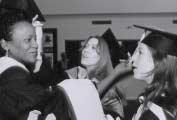
Commencement exercises for the Class of 2001 were held on May 21 at the Zellerbach Theatre,Annenberg Center. The V.M.D.degree was awarded to 101 graduates,74 women and 27 men.After the Academic Procession and entry ofCandidates, Dean Alan Kelly welcomed the audience. Chairperson ofthe School’s Board ofOverseers, Christine Connelly,congratulated the graduates.The Commencement Address was delivered by Peter Charles Doherty,B.V.Sc., M.V.Sc.,Ph.D.,F.R.S.,chairman ofthe department ofimmunology,St.Jude’s Children’s Research Hospital,Memphis,Tenn.Dr. Doherty,the first veterinarian to receive a Nobel Prize,earlier in the day had been awarded an University ofPennsylvania hon-
Beth Rachel Adler
Christine Marie Adreani ***
Elizabeth Bingham Agnew
Veronica Maria Ann Aksmanovi´ c
Patricia Diana Alexander *
Megan Elizabeth Andeer
Elizabeth Audrey Arbittier
Lydia Aris
Deborah Anne Aronson **
Natalie Sabrina Austin
Christina Marie Barndt
Christina Sue Barr
Katherine Michelle Bates
Stephanie Renèe Bupp Becker
Blayne Paula Bergenstock
Meredith Ann Borakove *
Todd Andrew Calsyn
Elsa Ileana Campos
Jonathan Mark Castro
Teresa Leigh Davenport
Timothy John Davenport
Ellen Tomi Davison
Christy Lyn Decker
Randall Derbin
Alexis Regina Dowidchuk
Debra Sue Eisenstein
Ruth Lillianne Magoon Eriksson
Rachael Feigenbaum
Emilie Appleton Fleming
Jennifer Forsyth-Hannon
Amy Lynn Franklin ***
Christina Lynn Fuoco
Diane Marie Gabriel
Cailin Hollahan Galvin
orary Doctor ofScience Degree.
Dean Kelly presented the diplomas to the newly hooded veterinarians.He was assisted by Dr.Michael Atchison,Dean’s Awardee for Leadership in Basic Science Education,and by Dr.Michaela Kristula,Dean’s Awardee for Leadership in Clinical Science Education,and Associate Dean Charles D.Newton.
Elizabeth A.Arbittier,class president,gave a talk and then received the class flag from Dr. Eric Bregman,V’95,president ofthe Veterinary Medical Alumni Society. Dr.Patricia Sertich, V’83,recipient ofthe Lindback Award for Excellence in Teaching,assisted Dean Kelly with the awarding ofprizes and Dr.Jeffrey Wortman,V’69,associate dean for curricular affairs,recognized the honor graduates.
Susan Estelle Gardner ***
Christine Marie Gebert
Daniel Mark Goldner
Meryl Laura Gupta
Dorian Lynn Haldeman *
Dana Jeanne Frances Harkin
Stephanie Joseph Haugen
Kristen Sands Haviland
Kenneth Loren Heilpern
Traci Renae Holder *
Edward Mini Hsu
Dawn Christine Hunsberger
Carrie Ann Hutchinson
Monica Villar Ilardi
Elizabeth Jo Johnson
Scott Jeffrey Kandell
Heather Maguire Kerr
Danielle Marie Kitz **
Kimberly Ann Klesse
Eric Desombre Lombardini
Kristina Gui-Qing Lu
Jennifer Ann Makem
Michael Phillip Mansfield
Jennifer Mary Marsden
Kathleen Ann Marsh
Margaret Anne McElwain-Siems
Megan Therese McGlinn
Brennen Arthur McKenzie **
Cheyney Meadows **
Lori Ann Miles **
Adam Dale Miller
Jamie Ellen Murphy
Samantha Coles Murray
Lisa Christine Noble
Marie Suzanne Paar
Heidi Phillips ***
Dr.Mark Guise,V’82,president ofthe Pennsylvania Veterinary Medical Association,administered the veterinarian’s oath.
The newly minted V.M.D.s marched out of the theatre to traditional music to celebrate their accomplishment with families and friends during a reception.
Matthew Downs Quinn
Raymond Charles Reiners
Darren Lee Richards **
Robert Willard Richardson,Jr.
Barry Harrison Rickman
Hope Renee Rinehimer
Diana Patricia Risel
Shelly Renee Rodewald
Scott Rosenbloom
Marjorie Lynne Rosmarin
Robert John Ludwig Runde
Tiffany Lauren Scanlon *
Carrie Ann Schlachter
Mathew Eliot Schmitt
Douglas Steven Scipioni
Aliza Joy Simeone ***
Julie Elizabeth Stephenson
Jason Ward Stull **
Jennifer Yeager Tavares
Juliene Lynn Throop ***
Lisa Michelle Trachtenberg
Brian Robert Turgeon *
René Alfredo Varela
Eugenia Vassiliev
Mellissa Lynn Voll
Katherine Ann Wentworth
Jonathan Penn Wilkerson
Regan Michelle Williams *
Alberta Maryethel Wister
Stefanie Worwag
Halleck Ross Wrigley
***Summa Cum Laude
**Magna Cum Laude
*Cum Laude
Leonard Pearson Prize
Eric Desombre Lombardini
J.B.Lippincott Prize
Susan Estelle Gardner
1930 Class Prize in Surgery
Heidi Phillips
Auxiliary to the American Veterinary Medical Association Prize
Patricia Diana Alexander
Auxiliary to the Pennsylvania Veterinary Medical Association Prize
Small Animal Award
Samantha Coles Murray
Large Animal Award
Elizabeth Audrey Arbittier
Faculty/Student Chapter,AVMA Prize
Robert Willard Richardson,Jr.
Phi Zeta Award
Amy Lynn Franklin
American Animal Hospital Association Award
Adam Dale Miller
American Association ofFeline Practitioners
Award
Megan Elizabeth Andeer
American College ofVeterinary Radiology Award
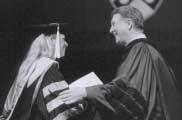
Brennen Arthur McKenzie
American College ofVeterinary Surgeons Prizes
Small Animal Surgery Prize
Juliene Lynn Throop
Large Animal Surgery Prize
Jamie Ellen Murphy
Banfield Family-Pet Bond Award
Shelly Renee Rodewald
Everingham Prize for Cardiology
Juliene Lynn Throop
Field Service Prize
Stefanie Worwag
The Peter Francis Anatomy Award
Darren Lee Richards
Hill’s Award
Marjorie Lynne Rosmarin
Iams/VECCS Award for Excellence in Veterinary Emergency and Critical Care
Katherine Michelle Bates
James Hazlitt Jones Prize in Biochemistry
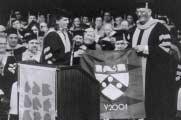
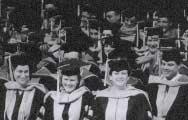
Susan Estelle Gardner
Large Animal Medicine Prize
Tiffany Lauren Scanlon
Large Animal Surgery Prize
Christine Marie Adreani
Merck Awards
Small Animal Award
Raymond Charles Reiners
Large Animal Award
Aliza Joy Simeone
1956 Class Medal for Achievement in Pathology
Christine Marie Adreani
Aliza Joy Simeone
George M.Palmer Prize
Carrie Ann Schlachter
Pharmacia & Upjohn Awards
Small Animal Award
Brennen Arthur McKenzie
Large Animal Award
Tiffany Lauren Scanlon
Charles F.Reid Sports Medicine and Imaging Award
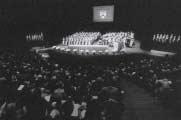
Carrie Ann Schlachter
Lynn Sammons Food Animal Award
Christine Marie Gebert
Morris L.Ziskind Prize in Food Animal Medicine
Cheyney Meadows
Morris L.Ziskind Prize in Public Health
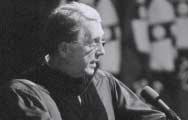
Brennen Arthur McKenzie
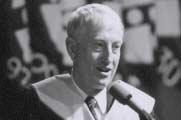
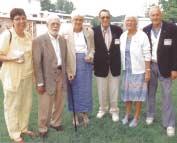

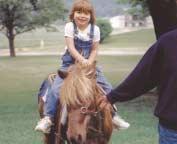
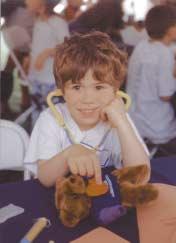


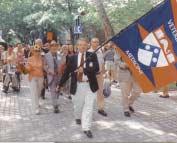

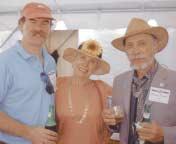
On May 18 to May 20,many alumni and their guests enjoyed attending a variety ofAlumni Weekend 2001 events this year on both the School’s Philadelphia and New Bolton Center campuses.From the Classes Without Quizzes presentation on “FreeRunning Horses:The Natural Life and Lessons Learned”by Sue McDonnell,Ph.D.,to a Special Species Medicine continuing education course,and from the School’s first ever appearance in Penn’s Parade ofClasses to the Alumni Picnic at New Bolton Center,Alumni Weekend 2001 was an exciting time for alumni to return to Penn.
Please mark May 10-12,2002,for Alumni Weekend 2002 and reunions for classes ending in “2”or “7”.
During Sunday’s Veterinary Medical Alumni Society Annual Meeting at New Bolton Center,Robert W. Stewart,Sr.,V’68 (right),1999-2001 Veterinary Medical Alumni Society President,is passing the President’s gavel to Eric M.Bregman,V’95,2001-03 Veterinary Medical Alumni Society President.
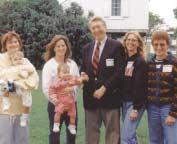

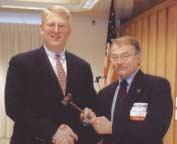
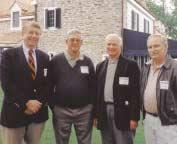
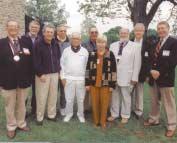
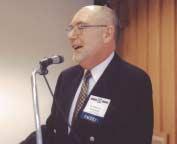
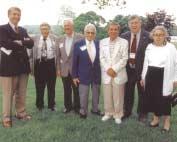
During Sunday’s Veterinary Medical Alumni Society Annual Meeting at New Bolton Center,Dr.Michael H.Goldschmidt,professor of pathology,is speaking after being presented with the Veterinary Medical Alumni Society Excellence in Teaching Award.This annual award is presented by VMAS to an educator recommended by recent graduates.
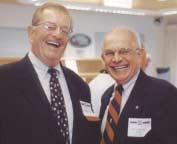
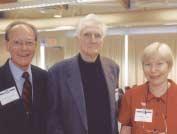
During the Annual Meeting ofthe Veterinary Medical Alumni Society (VMAS) ofthe University ofPennsylvania School ofVeterinary Medicine on May 20,2001,three alumni received a 2001 Alumni Award ofMerit.They are:
Dr.Earl Wesley Cook,a 1936 graduate.A resident ofHuntingdon Valley,Pa.,he cofounded QC,Inc.,a commercial laboratory for testing and quality control ofmilk,food,water, and the environment.
Dr.Charles D.Knecht,a 1956 graduate.A resident ofOpelika,Ala.,he is a former Professor and Head ofthe Department ofSmall Animal Surgery and Medicine at the Auburn University College ofVeterinary Medicine.
University ofPennsylvania School ofVeterinary Medicine
Veterinary Medical Alumni Society
Salutes
Earl Wesley Cook,V.M.D.
Class of1936
For co-founding QC,Inc.,a commercial laboratory for testing and quality control ofmilk,food, water,and the environment.
For taking a leadership role in Pennsylvania’s dairy industry by serving as President ofthe Pennsylvania Dairy Laboratory Directors Association and as an officer ofthe Pennsylvania Dairy Sanitarians Association.
For taking an active interest in your profession as a member ofthe American Veterinary Medical Association and the Pennsylvania Veterinary Medical Association.
For your continuous commitment to your alma mater as a Class Agent.
For your service to the community that promotes the good name ofthe School ofVeterinary Medicine,most notably as Chairman and Chairman Emeritus ofFox Chase Bank and as Chairman ofthe Board ofTrustees and as a member of the Advisory Board ofBethany Baptist Church.
For being recognized with the Four Chaplains Legion ofHonor Membership.
For your family’s legacy ofnine University of Pennsylvania graduates.
The Alumni Award ofMerit is presented to you this 20th day ofMay 2001.
Dr.Suzanne Ruch Jenkins,a 1966 graduate. A resident ofRichmond,Va.,she is assistant state epidemiologist in the Virginia Department ofHealth Office ofEpidemiology.
The VMAS honors alumni who have made outstanding contributions to their profession and the School with the Alumni Award of Merit.The award is given annually to recognize distinguished graduates for their contributions that advance knowledge in biomedicine,promote the welfare ofanimals through public education ofanimal owners,and benefit society through civic activities which foster the advancement ofthe profession and the School’s good name.
University ofPennsylvania School ofVeterinary Medicine
Veterinary Medical Alumni Society Salutes
Charles D.Knecht,V.M.D.,M.S.
Class of1956
For educating many veterinarians for more than 35 years in your faculty positions at various veterinary schools,most notably as Professor and Head ofthe Department ofSmall Animal Surgery and Medicine at the Auburn University College of Veterinary Medicine.
For taking leadership roles with various veterinary professional associations including the American College ofVeterinary Surgeons,the American Veterinary Medical Association,the American Association ofVeterinary Clinicians,the American Veterinary Neurology Association,and the American College ofVeterinary Internal Medicine.
For your numerous honors that promote the School ofVeterinary Medicine’s good name,including many teaching awards during your distinguished academic career; the Annual Award by the Alabama Academy ofVeterinary Practice; and the Heinz Cycle Award by the American Animal Hospital Association.
For your research projects that have led to new discoveries and for sharing your findings through numerous published articles and scientific presentations.
For your service to civic organizations including the Lee County,Alabama,Heart Association, and the Auburn University Academy for Lifelong Learners.
The Alumni Award ofMerit is presented to you this 20th day ofMay 2001.
University ofPennsylvania School ofVeterinary Medicine
Veterinary Medical Alumni Society
Salutes
Suzanne Ruch Jenkins,V.M.D., M.P.H.
Class of1966
For taking leadership roles in the National Association ofState Public Health Veterinarians and serving as Chair ofthe Compendium ofAnimal Rabies Control and Prevention.
For your service to the American Veterinary Medical Association as Chair ofthe Council on Public Health and Regulatory Veterinary Medicine and for serving on the Council ofState and Territorial Epidemiologists Executive Committee.
For numerous honors that promote the School ofVeterinary Medicine’s good name,most notably for being named an Honorary Diplomat by the American Veterinarian Epidemiology Society and for receiving the Society’s K.F.Meyer/James H. Steele Gold Head Cane Award,and for being named Distinguished Virginia Veterinarian.
For successfully obtaining numerous grants to conduct research in a variety ofpublic health and epidemiology subjects,including Public Health Preparedness and Response to Bioterrorism in Virginia.
For educating veterinarians and veterinary technicians as an adjunct professor and lecturer for over 10 years.
For your contributions to books,journals,and other written materials,which have advanced the knowledge ofyour fellow professionals.
The Alumni Award ofMerit is presented to you this 20th day ofMay 2001.
1952
According to Calvin Moon,1952 Class Agent, Joseph M Stoyak and his wife,Michele, visit New Orleans twice a year.In April 1996, Dr.Stoyak retired as chiefofstaffat the Rowley Memorial Animal Hospital,which is operated by the Massachusetts Society for the Prevention ofCruelty to Animals,in Springfield,Mass.He now performs mostly orthopedic surgery at several area hospitals.Also,according to Dr. Moon, Sidney H.Flaxman is recovering from a stroke he suffered last year.
During the Northwestern Pennsylvania Veterinary Medical Association’s regular meeting in March 2001, Melvin E.Vaclavik was honored with the Service Award for his dedicated years ofservice in veterinary medicine.After serving as president ofNWPVMA in 1960 he then became the secretary-treasurer in 1966. Dr.Vaclavik served in this position for 35 years having missed only five regularly scheduled meetings.
1958
Col.George F.Orthey,Jr.,was profiled in the May 11,2001,issue of The Sentinel of Carlisle,Pa.His Newport,Pa.,company, Orthey Instruments,manufactures autoharps. The company sponsors the annual Mountain Laurel Autoharp Gathering in Newport,which features concerts and workshops by internationally acclaimed autoharp performers and teachers.According to the executive director of the Perry County,Pa.Council ofthe Arts, “Thanks to George,Newport is the autoharp center ofthe universe.”Dr.Orthey served for 28 years in the United States Army Veterinary Corps before handcrafting autoharps full-time.
Todd Addis,a Master ofFoxhounds,has followed in the footsteps ofhis late father, Clarkson Addis,Sr.,V’17,who founded and was Master ofFoxhounds ofthe Perkiomen Valley Hunt,which later merged with the Whitelands Hunt,both in Southeastern Pennsylvania.He is a breeder ofthe Penn-Marydel variety ofAmerican foxhounds continuing the bloodlines his father established.Dr.Addis
published an interesting account ofhis father’s work with Penn-Marydel foxhounds and foxhunting in the March 2001 issue ofthe Friends ofPenn-Marydel newsletter.According to Dr. Addis,“Neither one ofus distinguished ourselves as veterinarians,but just tried to be good old country vets that served our communities with dedication and a clear conscience.”
Sherbyn W.Ostrich was honored with the American Veterinary Medical Association President’s Award during the AVMA Annual Convention in July 2001.The award is given to individuals inside and outside veterinary medicine who have had a positive impact on animal or public health,veterinary organizations,and the profession.A past president ofthe AVMA, Dr.Ostrich was selected for his pioneering achievement to engender a greater awareness of the changing economics ofveterinary medicine.
Donald B.Shatto is the veterinarian of Sheena,a dog that was inducted into the New Jersey Veterinary Medical Association/Ralston Purina Animal Hall ofFame during the Association’s Annual Meeting in March 2001.Sheena, a three-year-old lab and golden retriever mix, was inducted in the Companion Category, which recognizes animals that have provided a benefit to their human companions or community,for being the constant companion of an 82-year-old woman.The woman’s family says Sheena gives her purpose each day.
During the New Jersey Veterinary Medical Association’s Annual Meeting in March 2001, Maria Iannone was honored with a Distinguished Service Award for her contributions to the Association and the profession.
During the New Jersey Veterinary Medical Association’s Annual Meeting in March 2001, Suzanne J.Smith was elected President-elect for 2001-02.Dr.Smith is also the veterinarian ofCaber,a dog that was inducted into the New Jersey Veterinary Medical Association/Ralston Purina Animal Hall ofFame during the Association’s Annual Meeting.Caber,a four-year-old German Shepherd,received special recognition for being a hero for saving his human-family’s children from an attack by a rabid raccoon.He
is a registered therapy dog who visits schools and nursing homes,and a hard-worker who enjoys competing as a herding utility dog.
During the New Jersey Veterinary Medical Association’s Annual Meeting in March 2001, Mark W.Logan was elected President for 2001-02.
Kevin C.Skinner was recently promoted to Senior Vice President ofGenzyme Corporation,a leading biotechnology company in Boston.Prior to the promotion,he managed a 27-person research group and completed his MBA from the MIT Sloan School ofManagement.In his new position,he will manage the Biosurgery Division’s Research and Development Department,which is developing gene therapy and tissue engineered products for cardiovascular indications.
Christopher N.Garruba started the Nassau Animal Hospital in Princeton,N.J.,in January 2001.The small animal hospital’s mascot is 15year-old Ben,a fox terrier,who was adopted from VHUP by Dr.Garruba in his fourth-year as a student.
During the New Jersey Veterinary Medical Association’s Annual Meeting in March 2001, Joyce R.Koch was honored as the constituent association Veterinarian ofthe Year ofthe South Jersey Veterinary Medical Association.
Patricia M.Hogan’s pen and ink drawing, “Just Curious,”was featured on the cover ofthe June 15,2001,issue ofthe Journal ofthe American Veterinary Medical Association.She completed the drawing during a three-day trail ride moving a herd ofAngus cattle through Wyoming’s Big Horn Mountain Range,where she spent a summer while a student rounding up cattle on a ranch in Big Horn.She is a diplomate ofthe American College ofVeterinary Surgeons,specializing in equine surgery in Clarksburg,N.J.
Stephanie J.Murphy has been board-certified by the American College ofLaboratory Animal Medicine.Dr.Murphy is an assistant
professor in the Department ofComparative Medicine,Johns Hopkins University,School of Medicine,in Baltimore,Md.
After completing an internship in the Section ofMedical Genetics at VHUP, Steven E. Suter will be serving as a resident in Oncology at the University ofCalifornia,Davis,School of Veterinary Medicine.
Karen M.Froberg is the veterinarian of Mattey,a dog that was inducted into the New Jersey Veterinary Medical Association/Ralston Purina Animal Hall ofFame during the Association’s Annual Meeting in March 2001.Matty,a 12-year-old Lhasa Apso,was inducted in the Hero Category,which recognizes animals that have saved or preserved human life,for saving both human and animal lives by alerting his owner to a house fire.His efforts are so notable as he has an eye condition that has left him almost completely blind.
Caroline K.Garzotto has been board-certified by the American College ofVeterinary Surgeons.
Amy I.Bentz finished a large animal neonatology/perinatology internship at New Bolton Center’s George D.Widener Hospital for Large Animals and started a large animal medicine residency in July.
Jennifer Chaitman, Heather Peikes,V’98, and two former VHUP residents will be opening a specialty practice,Veterinary Internal Medicine and Allergy Specialists,in New York City in September 2001.Following a small animal internship at the Animal Medical Center in New York City,Dr.Chaitman completed her Internal Medicine residency at VHUP and is currently working for the Medicine Section.Dr. Peikes served as an intern for 1998-99 in Small Animal Medicine and as a resident for 19992001 in Dermatology,both at VHUP.The two former VHUP residents are Susan E.Kimmel and Patricia Kull.Dr.Kimmel served as an intern for 1996-97 in Small Animal Medicine and as a resident for 1997-99 in Internal Medicine,and is currently a lecturer for the Medicine Section.Dr.Kull completed her Internal Medicine residency last year and is currently working for the Medicine Section.
Anne E.Hessinger,a Captain in the U.S. Army's Mid-Atlantic District Veterinary Command,participated in the 2001 National Scout Jamboree at Fort A.P.Hill in Bowling Green Va.,from July 23 through August 1.
Capt.Hessinger helped to train and test Boy Scouts for the veterinary merit badge.“We're trying to show them a little bit about what veterinarians do,”Hessinger said about interacting with the Scouts.
1997
Alisa Iriye,a daughter,Alexis Julian,on May 29,2000.
1998
Joan Capuzzi Giresi,a daughter,Natalie Emily, on May 2,2001.She joins brother Michael.
2000
Athan V.Gerovasiliou,a daughter,Eleni,on May 25,2001.
1939
Russell D.Holt on March 10,2001. Sander A.Sacks on February 9,2001.
1940
John R.McCoy on February 20,2001.
1942
Carlos A.Rojas Maldonado in February 1996.
1943
Lt.Col.Bjarne N.Folling on August 20,2000.
Robert B.Weber on May 3,2001.
1944
Joseph G.Shute on June 16,2001.
1946
Glen W.Stevens on February 28,2001.
1951
Peter R.Cebulka on May 12,2000. David C.Tudor on November 17,2000.
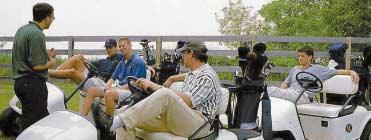
1957
William G.Stone on April 1,2001.
1970
E.Gregory MacEwen on May 12,2001.An internationally renowned veterinary oncologist, Dr.MacEwen was Professor and Head ofthe University ofWisconsin-Madison School of Veterinary Medicine’s Oncology Section.He was recognized posthumously with the 2001 American Kennel Club Career Achievement Award in Canine Research at the American Veterinary Medical Association Annual Convention in July 2001.He was lauded for his research as “novel,beneficial to the treatment ofcanine cancer,and providing significant translational information for human cancer.”
1987
Thurman Hornbuckle II,on March 30,2001.
Eric M.Bregman,V’95,considers himself an “answers guy.”Good thing … because as the newest—and probably youngest ever—president ofthe Veterinary Medical Alumni Society (VMAS) ofthe University of Pennsylvania School of Veterinary Medicine,Dr. Bregman will have to provide some critical answers regarding the most pressing needs and concerns ofthe School in the future.
During his term as VMAS president—May 2001 to May 2003—Dr.Bregman and his colleagues on the Executive Board will focus on several key issues,including the new Teaching and Research Building,student tuition costs, and the clinical education ofstudents that incorporates teaching practical skills.
With over halfofhis 20-or-so fellow board members over the age of45,Dr.Bregman,30, is undaunted by his youth.Rather,he considers it an asset.“Boards can get stagnant,”he explains.“We’ve made a real effort to bring in
some new blood and some fresh ideas.”
Furthermore,he’s accustomed to dealing with older veterinarians:His father,Jack,V’66, is his long-time mentor and partner in practice.
After growing up on a horse farm in New York’s Catskill Mountains,Dr.Bregman headed for the University ofHouston,where he studied biology for three years before being admitted to the School ofVeterinary Medicine.He completed a private-practice internship and then joined his father’s practice,which he helped expand from one to four offices in Brooklyn and Long Island and a feline hyperthyroidism treatment center.
Two ofthe four Bregman practices treat solely cats.Dr.Bregman calls feline practice “a nice way to practice veterinary medicine”—for the aesthetics,ifnothing else.When it comes to carpeting,laminated flooring,office space and staffing needs,he says,cats easily nudge out dogs.
Although he works 50-plus hours a week (and attends 25-30 New York Yankees games a year),Dr.Bregman credits practice ownership with giving him the flexibility to devote time to the Executive Board,whose membership requires a three-year commitment ofattending
five meetings annually.
Like his veterinary degree,Dr.Bregman’s VMAS membership is a legacy to his father, who is a veteran Executive Board member and former president.Starting out upon graduation as a “Pacesetter”—a board position reserved each year for one or two recent grads—Dr. Bregman,who is also active in the New York City and state veterinary medical societies,considers his VMAS participation a way ofreturning a very big scholastic favor.He shares his father’s appreciation for the School:“My dad says,‘The School gave me everything I have by educating me.They didn’t have to do that for me.They chose me.’”
“The opportunity for learning here is unmatched by any school in the country,” exclaims the younger Bregman,who credits the School with teaching him how to think logically about cases.“I may not have been the best at placing a catheter when I first got out of school,”he recalls,“but when a dyspneic cat came in,I knew what needed to be done.”
The School,too,can breathe easy as Dr. Bregman assesses the School’s needs and the help VMAS can provide. —J.C.G.

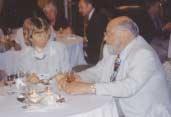
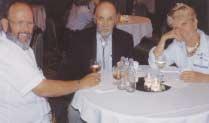

Nearly 100 School ofVeterinary Medicine alumni and their guests attended an alumni reception during the American Veterinary Medical Association Annual Convention in Boston on July 15,2001.Alumni from as far away as Puerto Rico (Jose M.Garcia Blanco,V’84) and Montana (Robert M.Frey,V’77,with wife,Pat) attended the reception.Dean Alan M.Kelly welcomed everyone to the reception and spoke about the School’s current activities and thanked alumni for their continued support oftheir alma mater.
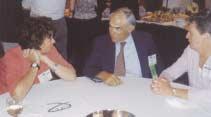
A major milestone in women’s rights and progress will be observed this fall when the University ofPennsylvania celebrates 125 years of educating women.This represented a break with the tradition ofattendance restricted only to males,which had been in existence for 136 years. It also was an extension ofPenn founder Benjamin Franklin’s feeling that education needed to be encouraged without regard to gender.
To commemorate this historic event,a celebration will be held November 1-2 and will include a ceremony honoring women “firsts”at the University;a talk by NBC ChiefForeign Affairs Correspondent and Penn trustee Andrea Mitchell;panel discussions,and a book signing and party for Penn women authors.
In addition,the existing Class of1949 Bridge across 38th Street and its approach has received a major refurbishing to create a Women’s Walkway and Generational Bridge recognizing Penn families.More information on the event,including a complete schedule,is available online at <www.alumni.upenn.edu/celebratewomen>. ◆
Philadelphia-area veterinarians are asked to be alert to a rash ofarmed robberies at veterinarian offices this summer.The offices are being targeted for Ketamine,an animal anesthetic that,when mixed with sugar,becomes the designer drug Special K and is often sold at “rave”parties.As oflate July,two ofthe three robbery suspects have been arrested by the Philadelphia Police Department.
According to the National Crime Prevention Council,ifa robber confronts you,cooperate. Merchandise and cash can always be replaced—people can’t! For crime prevention tips for small businesses,visit the NCPC web site at <www.ncpc.org/1smbus.htm>.
Recent Penn graduates working in the Empire State are encouraged to participate in the New York State Veterinary Medical Society’s (NYSVMS) Mentor Program,which helps to ease the transition from student life to professional life by providing new veterinarians with a mentor.Mentors act as sounding boards and offer practical advice about handling the challenges that face new veterinarians.
Mentors can also help to integrate young
veterinarians into the larger veterinary community by joining them at regional meetings, introducing them to colleagues,answering questions,helping them to access information, etc.The mentoring may take whatever form works best for the pair — meetings,telephone conversations,e-mail,etc.
To find a former classmate and to sign-up for a permanent e-mail forwarding service: Join the University ofPennsylvania Alumni On-Line Community for free at <www. alumniconnections.com/olc/pub/UPN>.
After you register,you can search the OnLine Directory,which is a great resource for personal and professional networking and an easy way to keep up-to-date on fellow alumni.You can also sign-up for a permanent email forwarding service,which will forward messages received at your permanent Penn address to the e-mail address ofyour choice.
To update your alumni record:
You can update your record via the University ofPennsylvania Alumni On-Line Community On-Line Directory.You may also contact Elizabeth McNamara at (215) 898-1481 or via e-mail at <emcnamar@vet.upenn.edu>.
To make a gift or for information on supporting the School ofVeterinary Medicine: Make a gift with your credit card through a secure online transaction at <www.upenn.edu/gifts>.For information on supporting the School,visit the Alumni & Friends web site at <http://alumni.vet.upenn.edu> or contact Joshua E.Liss at (215) 898-1481 or via e-mail at <lissj@vet.upenn.edu>.
To request a transcript and/or proofofgraduation: For information on requesting a transcript,visit the Office ofthe University Registrar’s web site at <www.upenn.edu/registrar/trans.html> or call (215) 898-7511.For information on requesting a certification ofgraduation, which does not require a transcript,contact the School’s Office ofStudent & Curricular Affairs at (215) 898-3525 or via e-mail at <student-affairs@vet.upenn.edu>.
The Mentor Program has a circle ofmembers excited about being a mentor.Ifyou’re interested in talking with a colleague or would just like to meet an area colleague at a regional meeting,please contact the NYSVMS at (518) 437-0787,toll-free at (800) 876-9867,or via email at <NYSVMS@albany.net>.
To obtain a Penn Alumni Card:
The Penn Alumni Card offers a myriad of benefits,including access to the Penn Libraries.The charge for the card,which is valid for 10 years,is only $20.Alumni Cards are issued at the PennCard Center,which is located in the Franklin Building at 3451 Walnut Street.In order to receive the card,alumni are asked to show a form ofphoto identification (a valid driver’s license,passport,etc.) and complete an Alumni Card Request Form. It then takes only a few minutes to take a photo ofthe alumnus/alumna and for them to receive their Alumni Card.As an added convenience,alumni can also obtain an Alumni Card by mail.For more information or to download a request form,visit the “Obtaining a PennCard”web page at <www.upenn.edu/penncard/obtaining.html>.
Alumni Relations and Annual Giving Staff
Joshua E.Liss
Director ofAlumni Relations and Annual Giving
(215) 898-1481 Fax (215) 573-3544
E-mail <lissj@vet.upenn.edu>
Elizabeth McNamara
AnnualGiving Coordinator
(215)898-1481 Fax (215) 573-3544
E-mail <emcnamar@vet.upenn.edu>
Please address any correspondence to: Office ofDevelopment and Alumni Relations
University ofPennsylvania
School ofVeterinary Medicine
3800 Spruce Street
Philadelphia,PA 19104-6047
Alumni are invited to attend a presentation, “Survival Tactics for a Chaotic Millennium”by Dr Gerr y Snyder, on Saturday, Nov. 10, 2001, from 9:00 a.m.-5:00 p.m.in the E.R. Marookian,V.M.D.Auditorium at VHUP.The presentation is sponsored by the Veterinary Business Management Association ofthe
University ofPennsylvania School ofVeterinary Medicine and Hill's Pet Nutrition, Inc. For more information, contact Bill Culp, V’04, at (215) 805-0059 or via e-mail at <wculp@mail.vet.upenn.edu>.
Alumni may use Franklin,the Library’s online catalog,NLM’s PubMed (MEDLINE) database,and a free version ofthe USDA’s Agricola database.These are available both in the library and remotely from your home or office.PubMed is available directly from NLM at the following web address:http://www.ncbi.nlm.nih.gov/entrez/query.fcgi
The USDA’s Agricola database is available at http://www.nalusda.gov/ag98/
In addition,the Penn Library has made an Alumni portal to our web site which provides links to many more electronic resources,including books,journals,and databases.Please visit this web site at http://www.library.upenn.edu/portal/ to access Franklin and much more.To view a list ofthe library’s new books,click “Franklin,”then click “new books.”
Alumni who want to borrow materials from the Penn Libraries’collections may apply for courtesy borrowing privileges at the special alumni rate of$200 per year.The Penn Alumni Card must be presented upon application for courtesy borrowing privileges.Application for courtesy borrowing should be made Monday through Friday to the Van Pelt Circulation Department.Call (215) 898-7566 for more information.
Alumni may use the collections for their information needs on weekdays,9 AM to 5PM.A librarian is on duty between 9:00 AM and 5:00 PM weekdays.An appointment is recommended ifyou anticipate needing librarian assistance.For reference service please call (215) 898-8874.
Prospective employers with job openings available for veterinary associates may now post employment opportunities on-line,and veterinary associates seeking positions may view them at: http://www.vet.upenn.edu/StudentResources/Employment/
Only listings requiring a graduate degree in veterinary medicine (VMD or DVM) will be posted.As opportunities for technicians/office personnel will not be advertised,we suggest you contact the classified section of Veterinary Technician magazine <http://www.vetclassifieds.com>.
Job listings will be posted on-line after being reviewed by the Office ofStudent Affairs. Prospective employers may be contacted by the Office ofStudent Affairs for verification of information.Listings will remain active and accessible for 6 months.
Beginning August 15,2001,paper opportunities will not be accepted.The paper version of the job book will remain available to potential applicants until November 1,2001.
Ifyou are seeking employment or have a position available,please use our on-line “Employment Board.”We hope you find this on-line employment opportunities web site helpful.
The Salsbury Scholarships were awarded to Amy Faulls,V’02, Heather Lyons, V’02,Brian Young,V’02, Shari Silverman, V’02,and Karen Oberthaler,V’02.The Lois F.Fairchild Scholarship in Veterinary Public Service was awarded to Jennifer Jones,V’03 Jill Compton,V’04 received the Harry B.Roshon Dean’s Scholarship.The New York Farmers Dean’s Scholarships were awarded to Tracy Filler,V’02, Siobhan Haney,V’04,and Holly Edwards,V’04.The J.Maxwell Moran,Sr.Dean’s Scholarships were given to Karen Mondzeil,V’04, David Bessler,V’03, Megan Julian,V’02, Danalyn Dess,V’02,and Julia Lane,V’03. Raul Casas-Dolz,V’04 received the Dr.John Baxter Taylor Dean’s Scholarship. Scott Gellman,V’04, Jennifer Gschwend,V’02, Sherry Cokefair,V’02 and Simon Alexander,V’04 each were awarded a Samuel T. and Emily Rawnsley Dean’s Scholarship. The Ethel G.and Allen H.Carruth Dean’s Scholarships were given to Christa Regan, V’04 and Erik Herrema,V’03.The Henry S.McNeil,Jr.Dean’s Scholarship was awarded to Holly Connolly,V’03 Michael Cohen,V’02 received the Hill’s Pet Products Dean’s Scholarship. Amy Hancock, V’02 and Meredith Daly,V’03 were awarded The Bruce J.Heim Dean’s Scholarships. The Dr.Josephine M.Deubler Dean’s Scholarship was awarded to Sara Langsam, V’02. Anna Skope,V’03, David Kersten, V’03,and Sarah D’Oench,V’02 received The Mrs.Jack L.Billhardt Dean’s Scholarships.The Charles S.and Phyllis H.Wolf Dean’s Scholarships were awarded to Johanna Briscoe,V’02,and Emily Kupprion,V’02. JeffLuetke,V’02, Kathy Heym,V’04,and Danielle Springer,V’02 were awarded The Anne Linn White Dean’s Scholarships. Erin Mairs,V’02 received the Pfizer Animal Health Scholarship and the The American Kennel Club Scholarship. Nathan Harvey,V’03 was awarded scholarships from Maine Veterinary Medical Association and the Veterinary Scholarship Trust ofNew England.The Dog Writers’ Educational Trust awarded a scholarship to Heather R.Jones,V’02
There are many breeds recognized by foreign registries but not by the American Kennel Club.In this country,these are considered “rare”breeds.AKC has established a Foundation Stock Service (FSS) for breeds recognized by an acceptable foreign or domestic registry. This is a record keeping service.Dogs with a FSS certificate are not eligible to compete at AKC events until they meet certain criteria, including a good number ofdogs in this country owned by many different individuals,existence ofa parent club and a breed standard.
Recently,AKC has admitted six FSS breeds to the Miscellaneous Class.These dogs may compete in obedience and other performance events.They cannot compete in regular conformation classes to earn the title ofchampion.
Following are a few notes about these six breeds.
The Beauceron is a French herding breed.It stands between 25 and 30 inches at the withers. The coat is short and the color is black and tan. The ears are cropped but the tail is long.
The black Russian terrier was developed in Moscow by crossing giant schnauzers with Airedales,Rottweilers and a local retriever.The breed was intended for military and police work.Its height is 25 to 28 inches.The coat is thick and wiry,up to four inches in length and black in color.The tail should be docked short.
The Glen ofImaal terrier is an ancient breed from southern Ireland which was used for hunting.About 14 inches high,it resembles the Sealyham but is more heavily boned.It has a soft undercoat and topknot and a harsher topcoat.
The Neapolitan mastiff,called mastino in its native Italy,goes back to ancient Rome.It is an extremely bulky dog just under 30 inches in height,with a large wrinkled head.The breed was originally used for fighting but is not naturally aggressive.
The Nova Scotia duck tolling retriever is a medium-sized dog about 20 inches height with a double,medium-length water-repellent coat. The color is shades ofred.It was developed in the early twentieth century from various breeds including the golden,Chesapeake and Labrador retriever.This dog is an outstanding swimmer and a natural retriever on land and in the water.The dog will play on the shore to lure ducks within shooting distance and then
retrieve the kill.
The Redbone coonhound is an American breed developed in the 18th and 19th century using red hounds from Europe.Some say Peter Redbone,a Tennessee breeder,gave his name to this hound while others believe the name come from the color.A treeing dog called a Redbone hound has been bred for a hundred years.Similar to the American foxhound but red in color, these dogs are about 25 inches tall with short, smooth,hard coats.Redbones are widely used and have a marvelous nose and voice,trailing ability and a strong desire to tree their game.
A review ofcases from the ASPCA Animal Poison Control Center revealed evidence of renal failure in ten dogs that ingested large amounts ofraisins or grapes.Sun-dried raisins and fresh grapes from grocery stores and private yards as well as grape crushings from wineries were involved.The known amounts ranged between nine ounces and two pounds.
Vomiting began within a few hours of ingestion.Other signs were loss ofappetite, diarrhea,lethargy and abdominal pain.High serum concentration ofcreatinine developed 24 hours to several days after ingestion,along with reduced output or complete suppression ofurine.Some dogs recovered after aggressive treatment,but two died and three were euthanized because ofpoor response to treatment.
There also have been reports ofserious illness or death after a dog has eaten large amounts ofchocolate candy.
Dietary indiscretion may have serious adverse effects.There are many poisonous plants and household chemicals that might be eaten by pets.Ifyou call your veterinarian for advice,try to be sure you can report how much and what the animal has eaten.
The ASPCA 24-hour emergency information number is 888-426-4435.There may be a charge which may be paid by credit card.
The Egyptian Mau is the only natural spotted breed ofdomesticated cat.It was brought to the United States in 1957.The coat is a transition between spots and stripes which appear not only in the fur but also in the skin pigmentation. Three colors are recognized by the Cat Fanciers Association — silver with charcoal markings,
bronze (honey-colored) with dark brown markings and smoke black with charcoal spots.They are quiet,friendly,medium-sized cats.
The Ocicat,named after the ocelot,was created in the 1960s by crossing Siamese,Abyssinians and American shorthairs.The Abyssinian influence gives energy,Siamese influence makes the Ocicat chatty and sociable and the American shorthair has a mellowing effect.The result is a cat that is not hyperactive and not too vocal and is people-oriented.The breed is recognized by the CFA.
The pixie-bob comes from a litter believed to be from an unplanned mating ofbobcats and barn cats,but this has not been proven. Developed less than 20 years ago,the breed is recognized by the The International Cat Association and is seeking recognition from the CFA. The TICA standard calls for a wild look — it is bred to resemble a domestic version ofthe Pacific Northwest coastal red bobcat.The ears are lynx-shaped.The standard allows polydactyl cats with up to seven toes per foot.The color is described as “light to medium shades ofbrown tabby in a random ‘buckshot’pattern preferred with a base ofmousey gray,like a wild hare.” The breed has long and short-haired varieties.

Parvovirus infection is a relatively new disease — the causative agent was first recognized about 1980.It is believed that it is a virus of some other species that adapted itselfto dogs. It is especially severe — often fatal — in puppies.Doberman pinschers and Rottweilers appear to be highly susceptible,but it occurs in all breeds.
The first signs are loss ofappetite and depression followed in a day or two by vomiting and bloody foul smelling diarrhea.The virus multiplies in the intestinal tract and billions ofvirus particles can be passed and will contaminate the environment for at least six months.Without killing all vegetation it is impossible to eliminate the virus from soil. Inside the home and kennel,thorough washing and use ofa chlorine bleach solution (one ounce in a quart ofwater) is effective.
Most older dogs are immune through vaccination or previous exposure to the virus.Bitches pass antibodies to puppies in milk and this will interfere with vaccination.For their protection,puppies should be vaccinated starting at
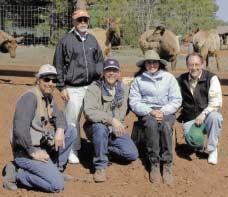
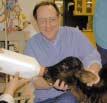 by Dr.Theodore Robinson,V’74
by Dr.Theodore Robinson,V’74
Agroup offour veterinarians,all graduates ofPenn,recently traveled to the Crown Point Navajo Reservation just north ofGallup,N.M.to provide veterinary care.
The week-long project was co-sponsored by Americans for Native Americans (ANA),located in Doylestown,Pa.and the Bucks-Montgomery Veterinary Medical Association,a constituent ofthe Pennsylvania Veterinary Medical
1.To educate the Native American population about the proper care and management oftheir pets and livestock.
2.To work with and help with the education and training of the veterinary technician students attending the Crown Point Institute ofTechnology.
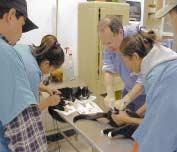
3.To help with animal population control and medically treat the reservation’s equine population.
Association.The volunteer group performed various veterinary medical procedures on the dogs,cats,horses and cows owned by the Native Americans living on the reservation. The veterinarians also conducted educational seminars.
The group consisted of Dr.Michael Tomasic,V’85,assistant professor ofanesthesia, Dr. Sherry Talowsky,V’75,and Dr.Joseph Raught, V’63 ofNew Wilmington,Pa.,and Dr.Ted Robinson,V’74 ofRichboro,Pa.Dr.Robinson is vice president and programs chairman ofthe Bucks-Montgomery VMA and he organized the entire project.
The objectives ofthe group were three-fold:
Animal Crackers continued
six weeks,repeated every two to three weeks until they are sixteen weeks old.
Infection is oral and usually results from exposure to contaminated soil.Keeping puppies inside does not keep them protected. Early vaccination is necessary to control the disease.Treatment frequently requires hospitalization and intravenous fluids because of dehydration.
To accomplish this lectures and workshops were held on the reservation in the evenings on various aspects ofequine,bovine,sheep and goat health management.All residents and veterinary technician students were invited to attend.The veterinary technician students participated in all aspects oflarge and small animal health care including preventative medicine.They assisted in all surgical procedures that were performed by the four veterinarians.The volunteers performed 166 spays,neuterings and vaccinations ofpet animals during their stay and more than 300 horses were treated for internal parasites and dental problems.
Four veterinary drug and supply companies donated the supplies that made the project possible.They were:Fort Dodge Laboratories, Pfizer Animal Health,Penn Veterinary Supply,and the W.A. Butler Co.The supplies included vaccines,anesthetic drugs, worming medications,suture material,surgical gloves and drapes,parasiticides,etc.
In conjunction with the project,four ofthe Crown Point veterinary technicians students came to Bucks County for internships at various veterinary practices.
All agreed that the project was extremely successful.To that end,ANA and the BucksMontgomery VMA will sponsor additional volunteer trips in the future,with the long term goal ofobtaining official AVMA accreditation for the veterinary technician school at Crown Point.
The annual Student Chapter ofthe American Veterinary Medical Association (SCAVMA) Auction will be held on Friday,December 7,2001,at 5:00 p.m.The location ofthe event is to be announced.Everyone is invited to support the auction!
The annual SCAVMA auction is a popular event for the entire School community.Proceeds from the Silent Auction help to fund student travel expenses to the annual National Student AVMA Symposium.Proceeds from the Live Auction help to fund SCAVMA events and the new SCAVMA Scholarship Program.The scholarship program awards two $2,500 scholarships annually for third- and fourth-year students.They are selected based on their service to the School, academic standing,and financial need.
The mission ofSCAVMA is to increase the quality ofveterinary student life through educational,social and cultural extracurricular activities.For more information on the auction or to donate auction items,contact J.Seth Eaton,V’04, Auction Co-Chairperson,via e-mail at <jseaton@mail.vet.upenn.edu>.
Bogie,a happy Labrador,suddenly became weak and collapsed.He was rushed to his veterinarian, Dr.Lisa Evans,V’88.He was stabilized and equipped with an IV for the drive to the Veterinary Hospital ofthe University of Pennsylvania.Doctors determined that he was anemic and in shock from severe bleeding ulcers in his stomach and intestines.The ulcers were likely due to sensitivity to aspirin,which Bogie was taking for arthritis ofhis knees.The ulcers were so severe that Bogie needed large amounts ofblood and plasma for two weeks until his ulcers healed completely.Bogie received a dozen pints ofblood products,more than his whole blood volume,during his hospital stay.Had there not been a refrigerator full ofdonor blood available,Bogie may have died. Bogie made a full recovery,and is doing well after a recent knee surgery.
“Bleeding and anemic dogs and cats are frequently referred to VHUP for life support with
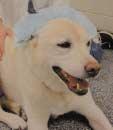
the appropriate and compatible blood component”states Dr.Urs Giger,director of transfusion medicine.These units ofblood come from the unique “pets help pets”volunteer blood donor program ofthe Penn Animal Blood Bank.Bogie’s guardians,Bill and Angela Wurster,realized that without the many blood transfusions Bogie may not have made it,and have been very gracious by supporting a proposal submitted to The Wurster Family Foundation for an animal blood mobile.This vehicle will facilitate the collection ofblood from hundreds ofvolunteer dogs.
Many investors today are nervous about volatile markets.They are turning to “safe”investments like certificates ofdeposit and municipal bonds for future income.But those options carry discouragingly low rates.
Penn is pleased to offer a secure alternative with attractive rates — the charitable gift annuity. Benefits include:
• Support for the School ofVeterinary Medicine • Guaranteed,fixed income for life
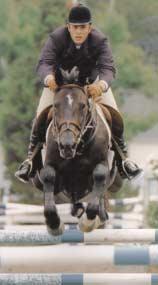
• Income tax deduction • Capital gains tax savings • Tax-free income (in part)
• Monthly,quarterly or annual payments • No management fees
• Option to defer income for higher annuity rate and deduction
Sample Rate Chart for a $25,000 One Life Charitable Gift Annuity*
Rate ofReturn
For more information or a personalized illustration with no obligation,call Penn’s Office of Gift Planning at 800-223-8236.
*Gift annuities may be funded with cash or marketable securities.Income may be current or deferred,for one or two people.Rates and deductions vary with age and number ofannuitants and the timing ofthe gift.Annuities with an income beneficiary over age 83 will receive a higher income tax deduction.Equivalent rate ofreturn refers to taxable investment alternatives,after factoring in tax savings for charitable gift annuity.Penn gift annuities are not available in all states.Please ask about other options.Minimum gift amount is $10,000.
University ofPennsylvania School ofVeterinary Medicine
Editor
Helma Weeks
Photographers
Jon Adams
Addison Geary
Tommy Leonardi
Charles Mann
Doug Thayer Writers
Helen Aceto,V.M.D.
Steven Bradt
Jennifer Chaitman,V.M.D.
Dr.Josephine Deubler
Joan Capuzzi Giresi,V.M.D.
Patricia Kane-Vanni,Esq.
Theodore Robinson,V.M.D.
Jane Simone
Alumni Relations Liaison
Joshua E.Liss
New Bolton Center Liaison
Jeanie Robinson-Pownall
We’d like to hear your praise,criticisms,or comments.Please address your correspondence to:
Helma Weeks
University ofPennsylvania
School ofVeterinary Medicine
3800 Spruce Street Philadelphia,PA 19104-6010
(215) 898-1475
hweeks@vet.upenn.edu
None ofthese articles are to be reproduced in any form without the permission ofthe editor of Bellwether.
©Copyright 2001 by the Trustees ofthe University ofPennsylvania.
The University ofPennsylvania values diversity and seeks talented students,faculty and stafffrom diverse backgrounds.The University ofPennsylvania does not discriminate on the basis ofrace,sex,sexual orientation,religion,color,national or ethnic origin, age,disability,or status as a Vietnam Era Veteran or disabled veteran in the administration ofeducational policies,programs or activities;admissions policies;scholarship and loan awards;athletic,or other University administered programs or employment. Questions or complaints regarding this policy should be directed to:Executive Director,Office ofAffirmative Action and Equal Opportunity Programs,3600 Chestnut Street,Sansom Place East,Suite 228, Philadelphia,PA 19104-6106 or (215) 898-6993 (Voice) or (215) 898-7803 (TDD).
On May 10,2001 the Philadelphia Museum ofArt began its 125th birthday celebration at Memorial Hall in Fairmount Park,the museum’s original home and the only exhibition building remaining from the 1876 Centennial Exposition.The School was asked to provide carriage transportation for the governor’s wife,Michelle Ridge,and Philadelphia Mayor John Street,to the stage in front ofMemorial Hall.The carriage was proceeded by outriders from the First City Troop and a Fyfe and Drum Corps.It made a pretty picture and horses and carriage were a big hit with the crowd.Shown here are whip Bruce Rappoport and groom Tricia Higginbotham driving Mrs. Ridge and Mayor Street.
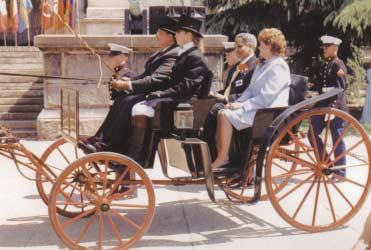
Dr.Chick Weisse,a surgical resident,and his colleagues are conducting a study ofthe use ofinterventional radiology in the treatment ofintrahepatic portosystemic shunts (PSSs) which traditionally are treated surgically.Surgical treatment is a challenge due to difficulty in locating the shunt at surgery,their large size, increased risk ofhemorrhage,and increased likelihood ofrequiring multiple procedures. Prognosis for “clinical improvement”in animals receiving these treatments is only 70-75 percent.The increased morbidity and mortality associated with surgical treatment ofintrahepatic shunts has inspired a search for alternative treatment options.
Recently,a number ofreports have described the use ofinterventional radiology techniques for the management ofdogs with intrahepatic PSSs.Thrombogenic coils were used for staged embolization ofintrahepatic shunts.
Interventional radiology techniques offer
the advantage ofshunt attenuation with simultaneous angiography and pressure measurements,shorter anesthesia times,minimal invasiveness,and avoidance ofthe morbidity associated with complicated,technically demanding surgical procedures.We have already performed a number ofthese procedures with the assistance ofa human interventional radiologist and have not experienced any serious complications to date.
We would like to offer this procedure as an alternative option for any cases ofintrahepatic PSSs and encourage veterinarians who have such cases in their practice to contact us for more information on the procedure.Inquiries from veterinarians should be directed to Dr. Chick Weisse at VHUP,3850 Spruce Street, Philadelphia,PA 19104. Owners ofdogs with the disease should have their veterinarian contact Dr.Weisse;unfortunately,he is not able to talk to owners to discuss their case
The following have made gifts to the Small Animal Hospital in memory of a special pet:
Mr.and Mrs.Curt Adams in memory of“CORDELIA”, “REGAN”and “MONGO”
Ms.Sandy Amador in memory of“CLYDE”
Mr.Salvatore Amato in memory of“BUTCH”
Mr.Joseph Anderlonis in memory of“NERO”
Mr.and Mrs.William Arnold in memory of“GRACIE”
Ms.Sue Zanne Artzner in memory of“ABACUS”
Ms.Joan M.Auten in memory of“DUNCAN”
Mr.and Mrs.Hershel Berris in memory of“CESSNA”
Ms.Allison Birenbaum in memory of“POLLY”
Ms.Barbara Blair in memory of“TAISHA”and “ZIMMER”
Ms.Alberta A.Booth in memory of“JODY”
Mr.Leonard Buster in memory of“TIFFANY”
Ms.Mary Butler in memory of“CUBBY”
Ms.Cindy Caine in memory of“DAMIEN”and “LUCIFER”
Ms.Jo Etta Campbell in memory of“BEAR”
Ms.Allison Chapman in memory of“CHOPPERS”
Mr.and Mrs.Wayne Carey in memory of“BARKLEY”
Dr.and Mrs.Tito Cascieri,Jr.in memory of“JAKE”and “SADIE”
Mr.and Mrs.Alfred Cavallaro in memory of“TROOPER”
Ms.Paula Clark in memory of“ONEY”
Mr.and Mrs.William Corcoran in memory of“BARNEY”
Mr.and Mrs.Stephen Colangelo in memory of“MONEY”
Mr.Wayne Conner in memory of“WOTAN”
Mr.and Mrs.Arthur Cook in memory of“DUNCAN”
Mr.Alan Dakers in memory of“BUDDY”
Ms.Irene T.Decker in memory of“STEFFIE”
Ms.Marguerite Delucia in memory of“HOLLY”
Mr.Robert Earle in memory of“GIZMO”and “YUKON”
Dr.and Mrs.Edward V.Dillon in memory of“BOOF”
Cynthia C.Eldredge,V.M.D.in memory of“HUDSON”
Mr.and Mrs.Donald Finn in memory of“BUSTER”
Ms.Karen Goodall Fernsten in memory of“TOBY”
Ms.Lois Francis in memory of“SWEETIE”
Miss Kirsten Gausch in memory of“HARRY”
Ms.Ellen Ger in memory of“TUTU”
Mr.and Mrs.Jonathan Goodman in memory of“BARNEY”
Ms.Nasima Hanna in memory of“GINGER”and “MIDNIGHT”
Mr.and Mrs.Hartman in memory of“BERNICE”
Ms.Tracy Lee Burton Hausel in memory of“TAMMY”
Mr.Jon Hechtman in memory of“LEFTY”
Mr.and Mrs.Raymond J.Higgins in memory of “STEPHANIE”
Mr.and Mrs.Wilson Hipley in memory of“PAL”, “MAJOR”,“GARETH”,“PHELAN”and “NICCI”
Ms.Frances Iadevaio in memory of“CARA MIA”
Ms.Kelly Inemer in memory of“VELVET”and “BABY TIGGER”
Ms.June Crawford Jackson in memory of“PIP”, “GINGER”,and “BRUCE”
Susan Jacobson,V.M.D.in memory of“TEDDY”
Ms.Michele Johnston in memory of“SASSY”
Mr.Barry Kaufman in memory of“PRINCESS”
Ms.Sheilah Kaufman in memory of“PRINCESS”
Mr.and Mrs.Steve Kazakoffin memory of“ATHENA”and “DELTA”
Ms.Carolyn King in memory of“BEAR”and “CASSIE”
Ms.Shelley Kirk in memory of“STEPPER”
Ms.Joan Kistler in memory of“WINSTON”,“LADY”and “RUSTY”
Ms.Patricia Klous in memory of“MOLLY”
Ms.Karen Knuepfer in memory of“MADDIE”
Ms.Ceil Kostick in memory of“LIBBY”and “MISTY”
Mr.and Mrs.Mark Kramer in memory of“SANDY”
Mr.Brian Kushner in memory of“MARMADUKE”
Mr.Christopher Levan in memory of“RIGGER”
Mr.Lewis Lillmer in memory of“MAX”
Mrs.Dorothy Marciniszyn in memory of“BENNY”
Dr.Harold Marder in memory of“KASSIUS”
Ms.Trish Martin in memory of“NORMAN”
Mr.and Mrs.David Martini in memory of“NUGGET”
Dr.Tomi J.McCann in memory of“BUDDY”
Mr.and Mrs.Jack McCormick in memory of“SAMMY”
Mr.and Mrs.Peter McDermott in memory of“BABETTE”
Mr.and Mrs.John McGlinchey in memory of“JACOB”
Mr.and Mrs.Sean McGrath in memory of“CHELSEA”
Mr.William R.McKeever in memory of“PAL”,“SCOTTIE”, and “PIPER”
Ms.Margaret McNamara in memory of“OLIVER WENDELL HOMELESS”
Ms.Suzanne McQuade in memory of“SEAN”
Mr.and Mrs.Matthew Moore in memory of“MAX”
Mr.and Mrs.Patrick Moroney in memory of“ZAKARY”
Ms.Laura Murray in memory of“PUMPKIN”
Ms.Denise Muschamp in memory of“BOOTSIE”
Ms.Mary Alice Musser in memory of“LILY”and “CHANCE”
Mr.and Mrs.Serge Nalbantian in memory of“SHEEBA”
Mr.and Mrs.John B.Nason,III in memory of“TALLY” and “BARUABY”
Ms.Diane Neun in memory of“BUDDY”
Mr.Robert Oxley in memory of“ANGUS”
Ms.Despina Page in memory of“DELPHIE”,“BUNKER”, “IKE”and “PEACHES”
Mr.and Mrs.Dominick Panetta in memory of “DUTCHESS ANNE”
Mr.and Mrs.David Park in memory of“HOBBES”
Ms.Sonya Peterson in memory of“OLIVER”
Mr.and Mrs.Duarte Pinto in memory of“SANDY”
Ms.Shari Pirone in memory of“PETEY”
Dr.and Mrs.Robert L.Quigley in memory of“OUR DOGS”
Mr.and Mrs.Frank M.Raine,Jr.in memory of“JASPER”
Ms.Stephanie Resnick in memory of“PRECIOUS”, “SIMBA”,“COLITA”,“SENATOR”, “BARCLAY”and “ITTY-O”
Ms.Arlene Robertson in memory of“NIBBLES”and “PEANUT”
Ms.Karel Rogozenski in memory of“MURPHY”
Ms.Nancy Rosenau-Thomas in memory of“MAX”
Mr.Charles Roumas in memory of“CHLOE”
Mr.and Mrs.Bill Roxby in memory of“LILY”
Ms.Joan Aigner Ruby in memory of“DUFFER”
Ms.Jean Ruhl in memory of“TESSA”
Mr.and Mrs.Thomas Russo in memory of“BUSTER”
Ms.Megna Sahni in memory of“SAMMY”
Ms.Joyce Satz in memory of“FRISKY”
Mr.and Mrs.Sauerwine in memory if“PRINCE”
Mr.Raymond Scarduzio in memory of“SAMM”
Mr.John Schafer in memory of“BUTCH”
Ms.Joan Schwer in memory of“GABBY”and “ROYALE”
Ms.Phyllis Shapack in memory of“ZIGGY”
Dr.M.Lana Sheer in memory of“ERIN”
Mr.and Mrs.Richard Schwoebel in memory of“TIMMY”
Mr.Daniel S.Shead in memory of“SHANA”
Mr.and Mrs.Brian Smith in memory of“CODY”
Ms.Diane C.Smith in memory of“TARA”and “WINSTON”
Mr.and Mrs.Robert Smith in memory of“MIKI”
Ms.Sylvia Smith in memory of“ALEX”
Mr.and Mrs.Robert F.Smoll,Jr.in memory of“MOLLY”
Mr.Philip Spinelli in memory of“TIGGER”and “NICHOLE”
Ms.Nona J.Starzyk in memory of“GINGER”
Ms.Mildred Stauffer in memory of“BUDDIE”
Mr.William Sterling in memory of“TARA”
Ms.Edna Stirk in memory of“NEELY”and “BRUTUS”
Ms.Irene Strum in memory of“FERNONDA”and “GINGER”
Mr.Joseph Sullivan in memory of“SPIKE”
Ms.Jennifer Sutherland in memory of“SCRUNGY”
Mr.William Sweeney in memory of“SKEETER”
Mr.and Mrs.Kevin Thibeault in memory of“TESSA”
Ms.Anna Tilghman in memory of“AM.CAN.CH. LIBERTYS CHIP OFF THE ARK,CDX,SCH III”
Mr.and Mrs.Anthony Trusso in memory of“TIGER”
Ms.Evadne Tsolo in memory of“BUDDY”
Mr.and Mrs.Richard Veneziani in memory of“TIGER”
Mr.John Vinci in memory of“PRINCESS”
Ms.Shannon Walsh in memory of“SHEA”
Ms.Wanda May Webb in memory of“CLARENCE”
Mr.and Mrs.Harry Weisser in memory of“FAUNA”, “MISTY”,“STINGRAY”and “TIFFANY”
Ms.Patricia Welsh in memory of“HOLMES”
Mr.Sidney Wexler in memory of“DUSTY”
Mr.William Widdows in memory of“LIZZY”
Ms.Marilyn Wiesen in memory of“SPARKY”
Ms.Emily Williams in memory of“LIBBY”
Mr.and Mrs.Paul S.Woodring in memory of“ZACH”
Ms.Suzanne Woodroffe in memory of“EMMY”
Mr.and Mrs.Kenneth Yeager in memory of“BAMA”,“BJ”, and “BAILEY”
The following have made gifts to the Small Animal Hospital in memory of those listed:
Ms.Nadine Blanchard in memory ofMr.Loman Booth
Mr.John Coyle in memory ofDarrell G.Nelson
Mr.and Mrs.John DiPolvere in memory ofRuth Kline
Ms.Eleanora Heim in memory ofMelvin Chayt
Mr.Sanford A.Gordon in memory ofAnita B.Gordon
Ms.Grace McDaid in memory ofKaren Eileen Spiegle, V.M.D.
Mrs.Gertrude Saunders in memory ofLeslie Saunders
Wyeth Nutrition Department in memory ofBeatrice Nazzario
The following have made gifts to the Small Animal Hospital in honor of a special pet:
Ms.Anne Abruzzese in honor of“TUG”
Ms.Heidi Adams in honor of“BARLEY”
Ms.Antoinette Armstrong in honor of“NATASHA”
Ms.Marti Arner in honor of“BRITTANY”
Dr.Patricia Baccash in honor of“CANDY”
Ms.Joan Bennett in honor of“BULLET”
Mr.Jack L.Brown in honor of“GUNTHER”
Mr.and Mrs.David Dietrich in honor of“MAX”,“LEDO” and “JAZZY”
Ms.Elizabeth S.Ertel in honor of“MEGAN”
Ms.Lois Francis in honor of“SWEETIE”
Mr.and Mrs.William Hayes in honor of“NIKKI”
Mr.James Hillenbrand in honor of“ABBEY”,“TASHA”, “LUCY”and “BUSTER”
Ms.Tammy James in honor of“RIDLEY”
Ms.Rebekah S.Klein in honor of“EBON”and “GRIFFIN”
Ms.Cynthia Liss in honor of“MIDKNIGHT”
Ms.Jeanette Molczan in honor of“SHANNON”
Mr.Thomas Pestritto in honor of“KATIE”
Ms.Shelly Ray Reed in honor of“TES”and “TYE”
Ms.Marie Taylor in honor of“BINDI”
The following have made gifts to the Small Animal Hospital in honor of those listed:
Mr.Jack L.Brown in honor ofDr.Lillian Aronson,Dr. Nicole Hays,Dr.Simone Ostermeier, and Dr.Hilary Fordyce
Ms.Denise Carr and Mr.James Lowry in honor ofDr. Judith Durkee
Mr.and Mrs.Charles K.Clark in honor ofElliot Tucker Clark
Dr.and Mrs.Edward V.Dillon in honor ofSt.George Hunt,V.M.D.
Ms.Mindy Friendmann in honor ofEllis Rubin,V.M.D.
Ms.Jackie Gottlieb in honor ofJosephine Deubler,V.M.D.
Ms.Carol L.Hawkins in honor ofMeryl Littman,V.M.D.
Dr.Susan Jacobson in honor ofMrs.Charles Hickox
Ms.Tammy James in honor ofChick Weisse,V.M.D.
Ms.Beth Liddle in honor ofDan Morris,D.V.M.
Ms.Rosanne Marzarella and Dante in honor ofKaren M. Froberg-Sleph,V.M.D.
Philadelphia Chapter Special Libraries Association in honor ofDr.Ravi Ganesan
Ms.Mae Shutter in honor ofDr.Griffin
Ms.Mary S.Smith in honor ofIra H.Silver,V.M.D.and Jarod E.Williams,D.V.M.
Ms.Irene Strum in honor ofDr.Weiner
Ms.Roberta Webb in honor ofBisque Jackson,V.M.D.
The following have made gifts to the Small Animal Hospital in memory of John Sacuto:
Ms.Louise Bade
Ms.Gayle Campbell
Ms.Lynn Colombo
Mr.and Mrs.Robert Delaney
Mr.and Mrs.Paul Hartman
Mr.and Mrs.Jonathan Hodson-Walker
Mr.and Mrs.Edward Janssen
Mr.and Mrs.H.Donald Morine
Mr.and Mrs.Frank Navarra
Mr.and Mrs.Hugh Nelson
Mr.and Mrs.Nick Poulos
Ms.Wilma Timian
Ms.Josephine Wardle
Ms.Barbara Witznns
The following have made gifts to the Josephine Deubler Genetic Disease Testing Laboratory in memory of a special pet:
Mrs.Helma Weeks in memory of“GAMBY”
The following have made gifts to the Student Scholarship Fund in memory of Linda DeVito:
Roger and Barbara Cowan
Jane Cowan
Michael Cowan
David and Beth Barnett
Deborah & Michael Goldstein
Mr.Stanley B.Judd
Mr.Jerry Rothman
The following have made gifts supporting Soft Coated Wheaten Terrier Research in memory of a special pet:
Mr.and Mrs.John Hurley in memory of“YEATS”
The following have made gifts supporting Junior Faculty Research in memory of a special pet:
Mr.Wallace Chavkin in memory of“JOOLY”and “REGGIE”
Mr.Philip S.Rosenzweig and Ms.Beth Zemble in memory of“ERNIE”
Ms.Nancy Sullivan in memory of“ZUBIN”,“BEAST”and “BEAUTY”
The following have made gifts supporting Megaesophageal Research in memory of Butch:
John W.Davidge III
Amber Denker
Deborah Lott
Sharon and Jeffrey Sabatini
Richard E.Schweitzer,M.D.
Sharon Lapid Schweitzer
Masaaki Shibusawa
Gregory and Ellen Simon
Lance Williams
The following have made gifts supporting the Behavior Clinic in memory of a special pet:
Ms.Gayle Share-Raab and Joel S.Raab in memory of “LUTHER”
The following have made gifts supporting Oncology Research in memory of a special pet:
Ms.Diane Copenhaver in memory of“ROBYN”,and “NIKKI”
The following have contributed gifts to the Dean’s Fund in honor of those listed:
Mr.and Mrs.Richard D.Trimpi in honor ofDr.Josephine Deubler
Howard Goldweig and Vesna Besarabic in honor Dr.Clifford
The following have contributed gifts to the Dean’s Fund in honor of a Special Pet:
Ms.Judith Moore in honor of“ZAPATA”
Mr.And Mrs.James Sharkey “BLAZE”
The following have contributed gifts to the Deans Fund in memory of those listed:
The Bright School c/o Ms.Marybeth Carney in memory of Joachim T.Beekmans
Brooke Roberts,MD in memory ofDrs.Mark Allam & Jacques Jenny
The following have contributed gifts to the Deans Fund in memory of a Special Pet:
Mrs.Karen O.Badellino in memory of“BARETTA PERLMAN”
Mr.And Mrs.Chester Barnes in memory of“EBONY”
Ms.Mary Darden in memory of“LITTLE DOO”
Howard Goldweig & Vesna Besarabic in memory of “CORDELIA”
John K.Harris,Jr.Esq.in memory of“BART”
Ms.Marilyn D.Moody in memory of“BLUE”
Rosemarie Murray in memory of“BAILEY MARIE”
Ms.Luda Shields in memory of“SANSI”
The following have contributed gifts to the Dean’s Fund in honor of Dr.Leslie King:
Mrs.Carolyn R.Cotter
Physical Therapy Service ofDelaware,Inc.
The following have contributed gifts to Veterinary Annual Giving Fund in memory of a Special Pet:
Patricia Schweibenz,V.M.D.in memory of“SKYLER”
The following have contributed gifts to Veterinary Annual Giving Fund in memory of those listed:
David Allgeier,V.M.D.in memory ofDr.Eric Tulleners
Richard H.Detwiler,V.M.D.in memory ofRussell Detwiler,V’15
Mrs.Paula A.Granger in memory ofJohn Granger and Dawn Elaine Granger
Peter H.Herman,V.M.D.in memory ofTerry Herman
Robert W.Nichols,V.M.D.in memory ofEdwin Churchill, V.M.D. South Street Veterinary Services,Inc.Andrew J.Breslin, V.M.D.in memory ofDr.Joan O’Brien
The following have contributed gifts to Veterinary Annual Giving Fund in memory of Dr.Robert B.Weber:
Ms.Donna L.Basehore
Mr.& Mrs.Mark Basehore
Ms.Susan K.Cone
Mr.and Mrs.James R.Dukes
Eureka Lodge F.& A.M.302
Mr.and Mrs.Daivd J.Fisher
Mr.A.Joseph Garner ofThe Garner Farm Halcyon Farm,Ltd.
Mr.George Hempt and the employees ofHempt Farms
Mr.and Mrs.Harold Keens
Mr.and Mrs.Roger Kopas
Mrs.Susan C.Jones
Ms.Kim L.Potter
Mr.Jack C.Ritter
Mr.David H.Russell
Mr.Raymond K.Sebright
Mrs.Molly Sebright
Mr.and Mrs.Richard D.Smith,Sr.
Mr.Stephen Ware
Ms.Audrey J.Weaver
Ms.Betty L.Weaver
Wesley United Methodist Church
Ms.Billie Jo Zeigler
The following gifts were made to Friends of New Bolton Center in memory of those listed:
Mr.and Mrs.Leonard M.Cohen in memory ofMr.Daniel Shalet
Nicholas G.Loutsion,V.M.D.in memory ofMr.George T. Loutsion,Sr.
Ms.Mary C.Peeples in memory ofMr.Marshall West Jenney
Mr.and Mrs.Luke M.Schlachter in memory ofMr.C. Lamar Creswell,Sr.
Eugene P.Steffey,V.M.D.in memory ofDr.Russell S. Detweiler,V’15
Mrs.Helma Weeks in memory ofMrs.Marion Stevens
The following gifts were made to Friends of New Bolton Center in memory of a special animal:
Ms.M.Heather Hevlow in memory of“SMOOTH TOWN KID”,1994 AQHA Gelding
Kilwinning Veterinary Services,Nancy A.Winning,V.M.D. in memory of“BOLD SPIRIT III”
Randi S.Semanoffand Just Jill Stables in memory of “JUSTIN”(Arctic Johnson)
Ms.Gail T.Szczecinski in memory ofNorthbrook (“BEACON”)
The following gifts were made in honor of those listed: Dr.Richard O.Davies in honor ofDr.Jill Beech
Mr.and Mrs.Daryl B.Nelms in honor ofDr.Jill Beech Neal Ralston,V.M.D.in honor ofDr.Charles W.Raker,Dr. Corinne Sweeney,and Dr.Raymond Sweeney
Mrs.Barbara Silverstein in honor ofMr.Tom Taylor Westtown Veterinary Limited,Kenton S.Stokes,V.M.D.in honor ofStuart A.Fox,V.M.D.
Ms.Carol A.Wolfin honor of“OPUS FOUR”and Dr.Tom Schaer and Dr.Karsten Velde.
The following gift was made to Friends of New Bolton Center in honor of a special animal:
Ms.Christine L.Simmers in honor of“WODAN”
September 2001
12
2:00-4:00 p.m.
Veterinary Medical Alumni Society Executive Board Meeting
Veterinary Hospital ofthe University ofPennsylvania
13-16
American Gold Cup
Devon Show Grounds
Devon,PA
Four day Olympic-caliber jumping competition to benefit the School ofVeterinary Medicine
19
7:30 p.m.
“A Tribute to New Bolton Center,Its Patients and Friends”
Inaugural Lecture by Dr.Jill Beech,the first recipient ofthe Georgia E.and Philip B.Hofmann Professorship in Medicine and Reproduction
New Bolton Center Kennett Square,PA
For more information,contact Patricia Hall at (610) 444-5800 x2500 or via e-mail at <phall@vet.upenn.edu>.
November 2001
10
6:00-10:00 p.m.
Rush Shippen Huidekoper Society Dinner
To recognize the School ofVeterinary Medicine’s most generous donors and friends The Academy ofNatural Sciences
Philadelphia,PA
14
2:00-4:00 p.m.
Veterinary Medical Alumni Society Executive Board Meeting
Alumni Hall
New Bolton Center Kennett Square,PA
25
6:00 p.m.
Alumni Reception
American Association ofEquine Practitioners’ Annual Convention
San Diego Marriott Hotel and Marina San Diego,CA
December 2002
7
5:00 p.m.
Annual Student Chapter of the American Veterinary Medical Association Auction
Location to be announced
For more information or to donate auction items, contact J.Seth Eaton,V’04,Auction Co-Chairperson,via e-mail at <jseaton@mail.vet.upenn.edu>.
January 2002
13
8:00-10:00 p.m.
Alumni Reception
The North American Veterinary Conference Orlando,FL
26
Annual Canine Symposium for Owners and Breeders
E.R.Marookian,V.M.D.Auditorium
Veterinary Hospital ofthe University ofPennsylvania
For more information,contact Dr.Josephine Deubler at (215) 898-8862.
30-31
2002 Penn Annual Conference Adam’s Mark Hotel Philadelphia,PA
30
2:00-4:00 p.m.
Veterinary Medical Alumni Society Executive Board Meeting at 2002 Penn Annual Conference
March 2002
13
2:00-4:00 p.m.
Veterinary Medical Alumni Society Executive Board Meeting Alumni Hall New Bolton Center Kennett Square,PA
23
Annual Feline Symposium for Owners and Breeders
E.R.Marookian,V.M.D.Auditorium
Veterinary Hospital ofthe University ofPennsylvania
For more information,contact Dr.Josephine Deubler at (215) 898-8862.
May 2002
8
2:00-4:00 p.m.
Veterinary Medical Alumni Society Executive Board Meeting
Veterinary Hospital ofthe University ofPennsylvania
10-12
Alumni Weekend 2002/Reunions for Classes ending in “2” or “7”
University of Pennsylvania School of Veterinary Medicine 3800 Spruce Street
Philadelphia,PA 19104-6008
Address correction requested